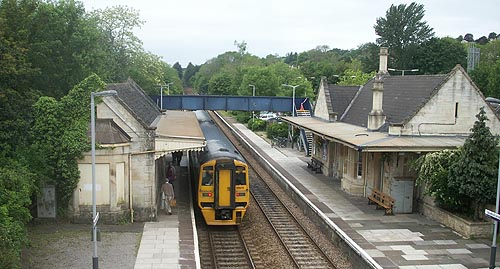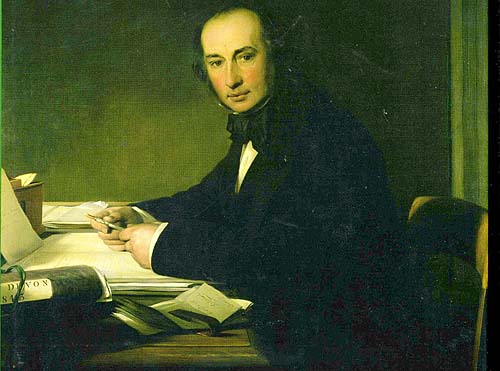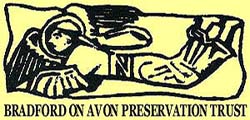
EXHIBITION
at Bradford Library
A
comprehensive look at
150 years of the Railway
2007
marked the 150th Anniversary of the Station at Bradford on Avon`s opening.
It was a year of celebration and there were a number of events to mark
it which are detailed here.
A book was specially produced by the Bradford on Avon Preservation Trust covering the history of this remarkable Station and its buildings which were designed by the great victorian engineer
- Isambard Kingdom Brunel.
A book was specially produced by the Bradford on Avon Preservation Trust covering the history of this remarkable Station and its buildings which were designed by the great victorian engineer
- Isambard Kingdom Brunel.
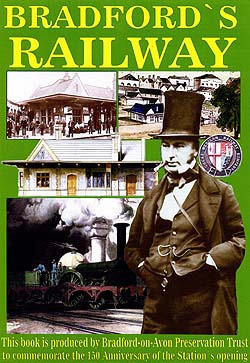
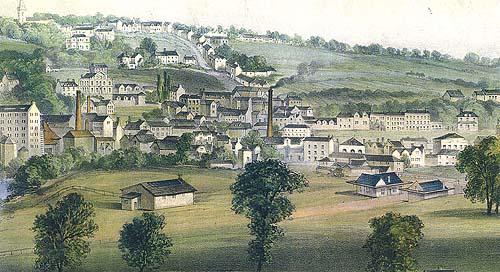
1830
On 4th January 1830 a public meeting at the Assembly Rooms in Bath, convened by a committee headed by Thomas Pycroft of Bath and John Harford of Bristol, heard William Brunton outline his ideas for a railway between the two cities. Brunton was a 52 years old Scots engineer whose chief claim to fame was the invention of a steam engine with a pair of mechanical feet which helped it to climb gradients. At a public demonstration it unfortunately exploded, killing 13 people. Brunton stressed that "by judicious selection of the line, and the arrangement made to the necessary embankments with arches of stone masonry, the road will be nearly level throughout…" - so no need for mechanical feet. Nothing further is heard of this proposal.
1832
1833
A preliminary survey was demanded in a month. Brunel, travelling on horse back and lodging at country inns, surveyed the Brunton route through the Vale of Pewsey and the Kennet valley, and a more northerly route via Swindon and Wootton Basset. The latter gave the opportunity for branches to Oxford and Gloucester; it was this that Brunel recommended, with an estimated cost of £2,800,000. The project was formally launched at a meeting on 30th July 1833 at Bristol Guildhall, where it was decided to form a company with a board consisting of directors from Bristol and London. A prospectus was issued in August 1833, naming 12 directors from each city and coining the name "Great Western Railway". Shares were
priced at £5 and money was quick to come in. To construct a railway and obtain powers for compulsory purchase of land it was necessary to obtain an Act of Parliament.
Isambard
Kingdom Brunel painted by his brother in law - John Callcott Horsley in
1857 .
1834
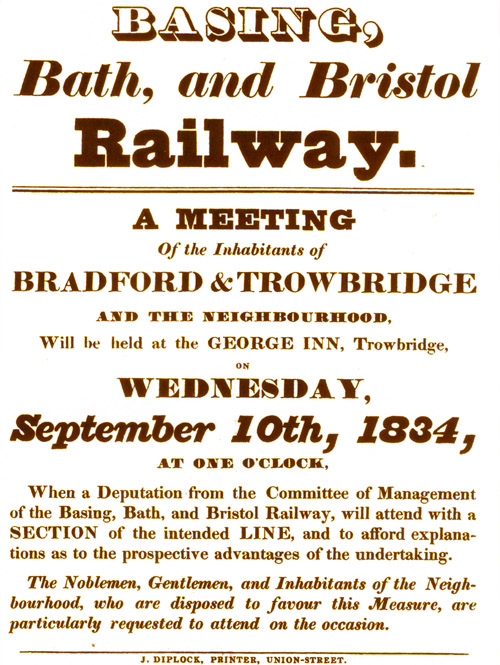
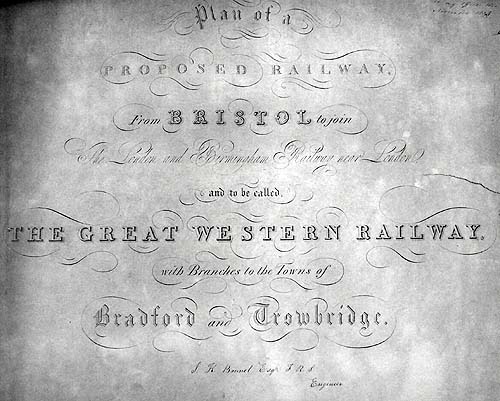
Frontispiece
to the early Plan for the Great Western including Bradford and Trowbridge
in 1834
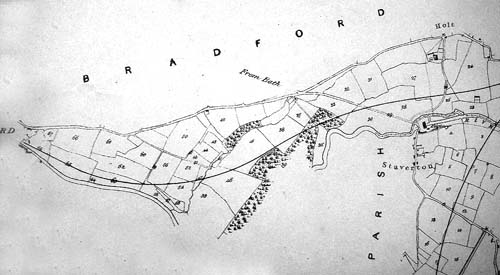
Map
showing original planned branch to Bradford on Avondated 1834, but never
proceeded with due to lack of funds.
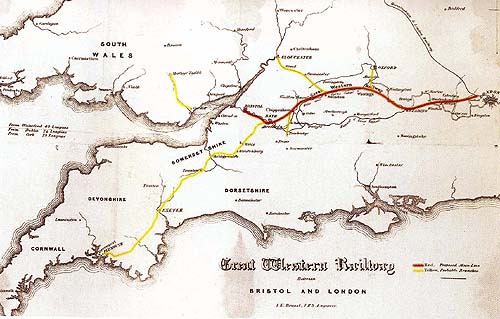
1835
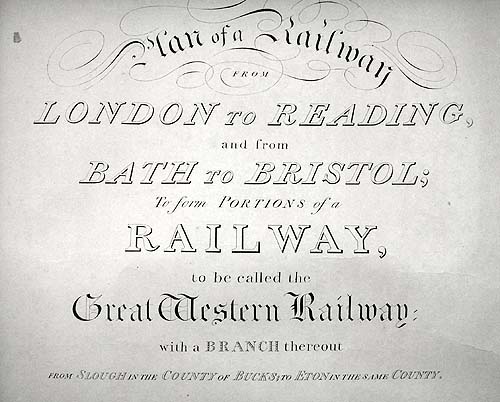
1836
1837
1838
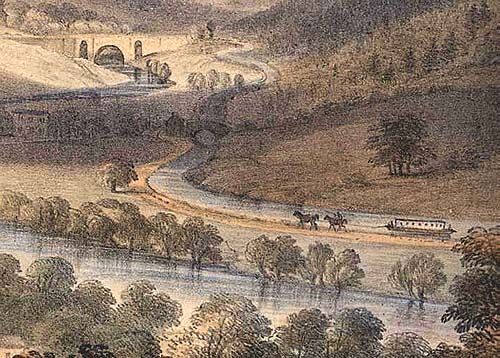
A
view showing a section of the Kennet and Avon Canal from Limpley Stoke
to Dundas Aqueduct, Claverton in 1850
1839
1840
1841
1843
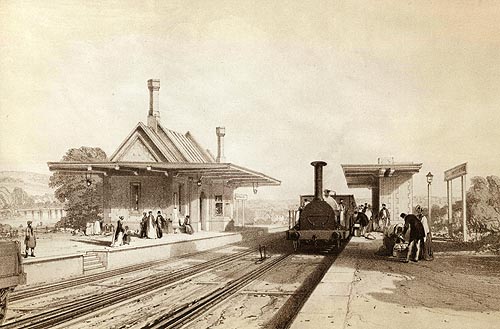
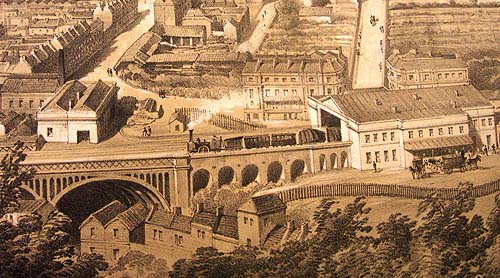
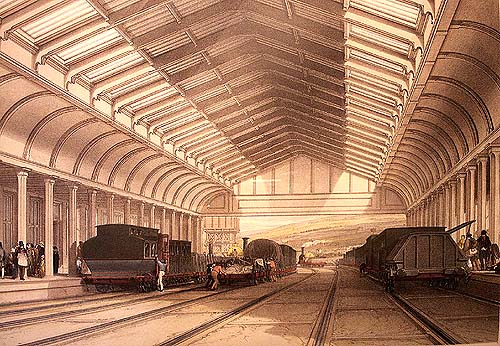
View
of Bath Station by Bourne in 1841. The roof covered all four tracks until
1897
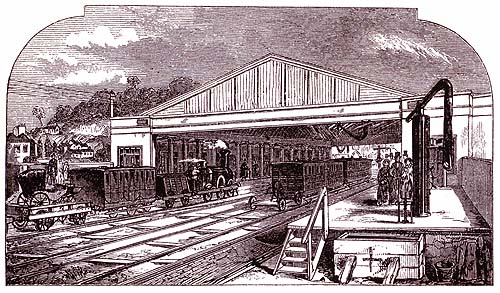
View
of Bath Station by George Measom in 1852
1844
The first meeting of the Wilts & Somerset was held at the "Bath Arms", Horningsham, near Longleat with Walter Long M.P. in the chair, on 9th July 1844.
Plans for the line had been submitted by Isambard Kingdom Brunel. Charles Alexander Saunders, Secretary of the G.W.R., attended the meeting and advised on raising the capital (estimated by Brunel at £650,000) for which the G.W.R. would be guarantor and offer a return of 3 ½% (later 4%) on each share , being itself prepared to subscribe up to half the capital. The G.W.R. was to have a perpetual lease and the right to work the line. A month later it was agreed to extend the line from Frome to Yeovil, and from Westbury to Weymouth, at an estimated cost of £350,000. At a further meeting the name of the company was changed to the Wilts, Somerset & Weymouth Railway. A bill was put forward and submitted to the recently established Railway Department of the Board of Trade, which had taken on the task of regulating the flood of new railway proposals. The Board of Trade stipulated that a better line of communication must be provided between the new railway and Bath and Bristol than by the junction at Thingley (though the extra mileage over this route would have boosted the profits on goods on the line).
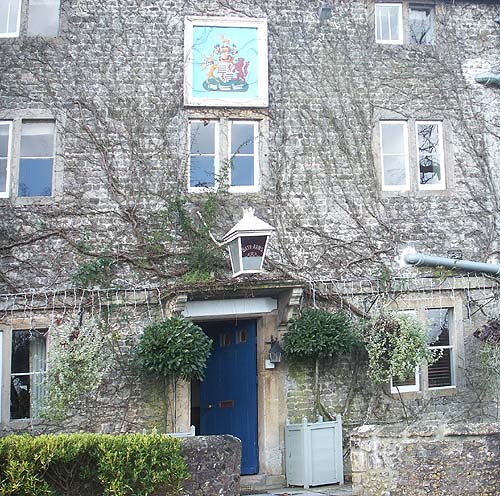
1845
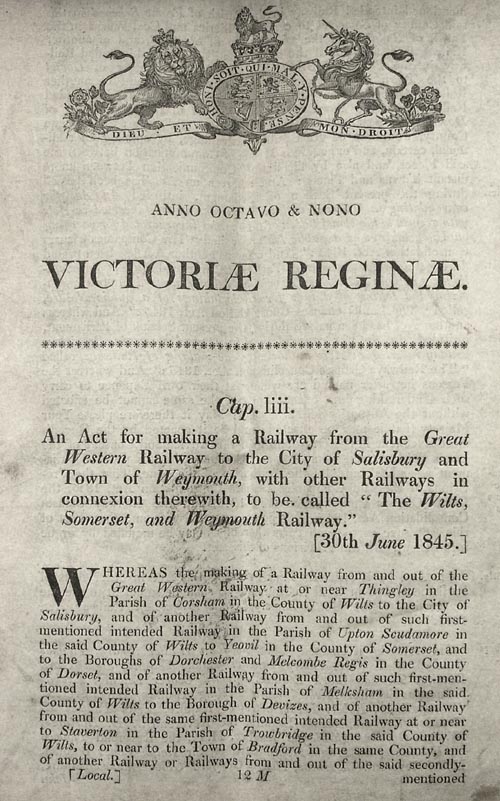
The
Act of 30th June 1845 detailing Bradford
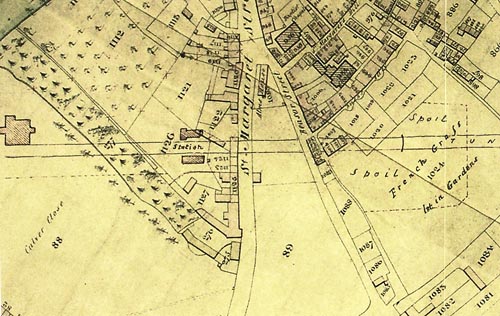
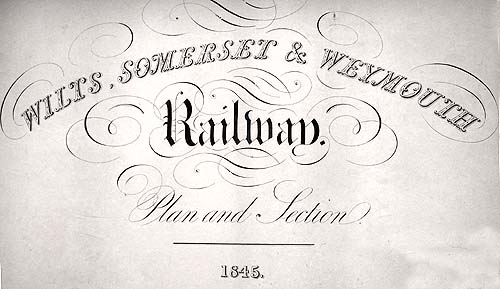
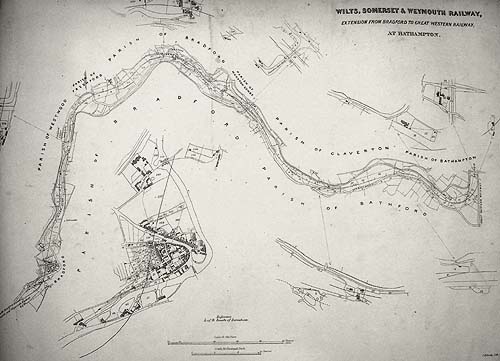
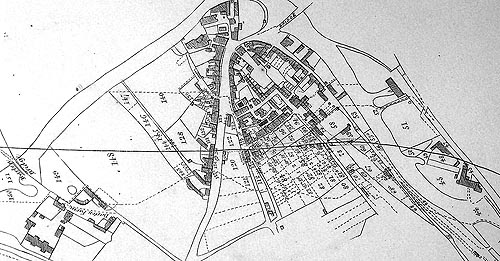
1846
The rush of new railway projects made it difficult to find firms to take on the work, but in February 1846 the contractor had erected workshops at Melksham and was "to break ground immediately". By August the Melksham and Trowbridge contracts were in full operation. Brunel reported to the Directors that in October a start would be made on laying the permanent way from Thingley to Bradford.
The "railway mania" of the 1840s led to greater demands for capital than the market could raise. It rose from about £4 ½ million for 1842 to £60 million in 1845 and £132 million in 1846, triggering the financial crisis that broke the WS&WR.
1847
John Bailey, a constable not in uniform, announced his status and ordered them to stop rioting. They replied by hitting him so hard that he later died of his injuries. Maurice Perry was the only navvy to be recognised and arrested and was later sentenced to death. The major engineering works on the line from Thingley to Westbury were undertaken. There was a complaint that work had proceeded on Sunday 21st march 1847 despite the rule against Sunday working. This had been at Ladydown, where water had to be run into a temporary channel to keep the Kennet & Avon canal open while the railway was tunnelled underneath it. More difficulties were found at Avoncliff where the banks of the canal were found to be insecure. A temporary aqueduct was built of timber prior to the railway tunnels and the restoration of the canal, but traffic on the canal was interrupted and a fine had to be paid.
1848
On the main line the rails were laid to Westbury and that section opened in September 1848. On Saturday 2nd September a special train driven by Mr Gooch, the locomotive department superintendent, assisted by Mr Brunel, drove a train of directors and special guests from Chippenham through Melksham and Trowbridge to Westbury. Crowds greeted the train: at Melksham the band played; at Trowbridge a cannon was fired, at Westbury the Mayor presented an address.
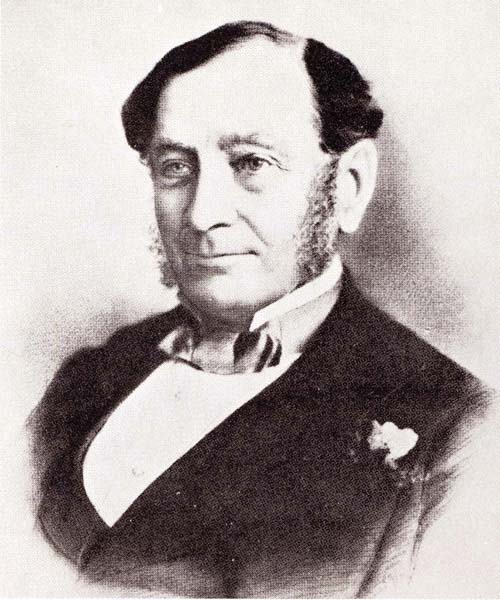
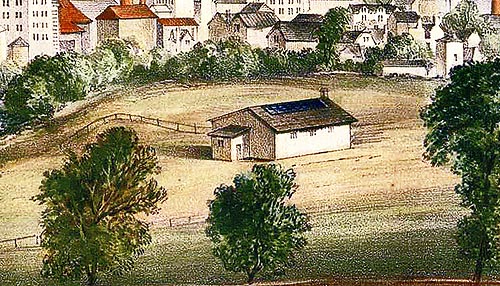
The
Goods Shed at Bradford on Avon in 1850 awaiting tracks
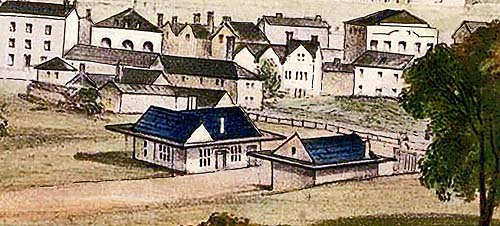
Bradford
on Avon Station in 1850,seven years before the opening showing all the
buildings completed.
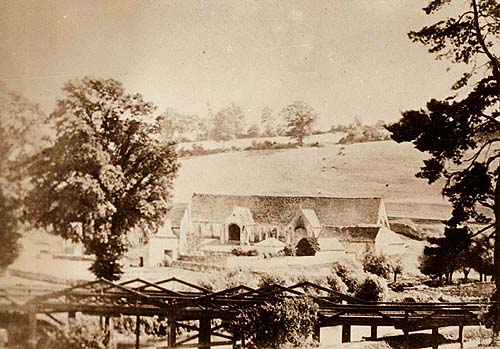
1849
On 4th June 1849 the G.W.R. Secretary wrote to the WSWR Directors saying it was the "strong and decided opinion" of his directors that all works should be stopped except those from Westbury to Frome. In October 1849 the WSWR directors resolved "that it is highly desirable that the railway should be sold to the Great Western Railway Company upon such terms as will produce to the shareholders in this company, the same rate of interest .. as is provided for them under the agreements between the two companies that was signed on 31st December 1849"; this gave the paid up shareholders a return of 4% on their investment.
1850
On 7th October 1850 the line from Westbury to Frome was opened. But on taking over the
WSWR the GWR had announced its intention of abandoning the Bradford branch. There was widespread dissatisfaction, as also among people in Devizes, work on whose branch was now suspended.
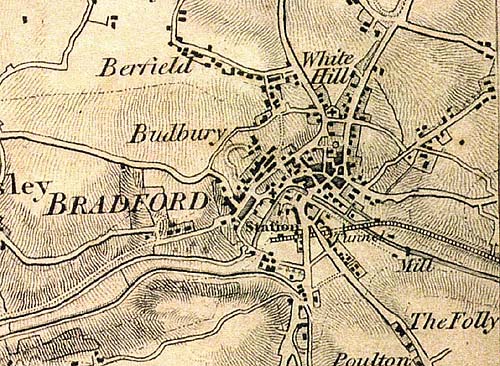
A
map of Bradford on Avon c.1850 showing the incomplete railway line
1852
A coalition of local interest brought an action against the GWR to compel them to complete the lines for which the Wilts Somerset & Weymouth Railway had possessed powers. It was heard at Somerset Assizes in the Michaelmas Term of 1852; the lawsuit was defeated, except for the Bradford to Bathampton branch.
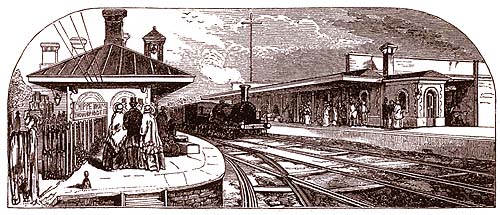
Chippenham
Station in 1852
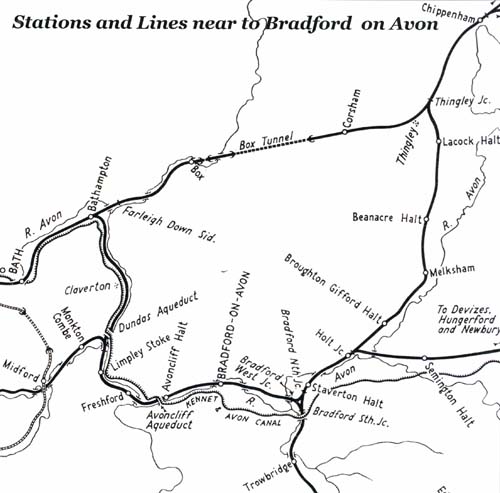
1853
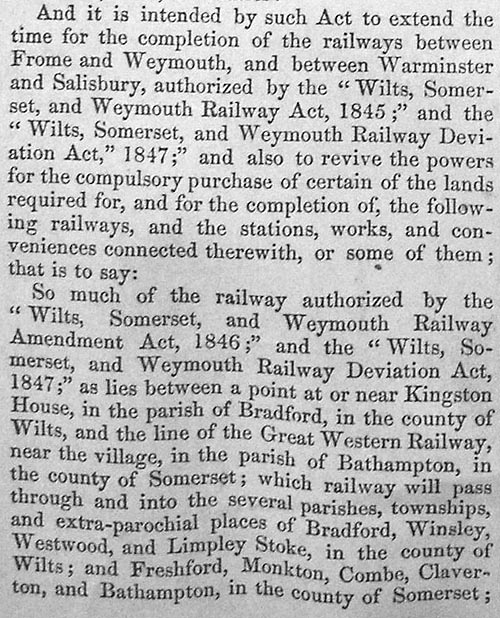
An
abstract from the Act of 1854 dealing with the extension from Bradford
to Bathampton
1854
Powers were granted to raise an additional £1,000,000 in capital.
Negotiations were re-opened with land owners along the route, a timber bridge built over the Avon at Barton Farm and other engineering work re-started.
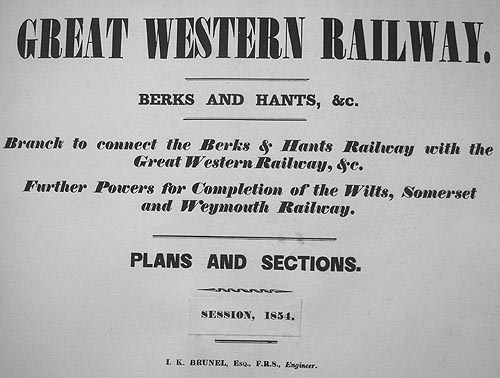
1855
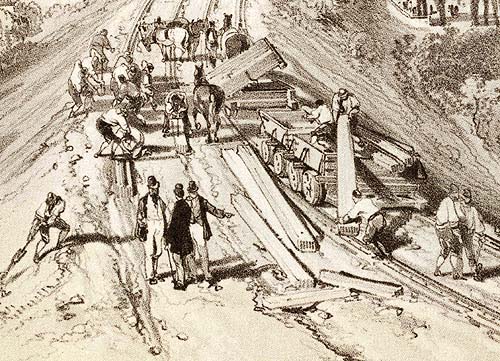
This
print by Bourne shows track laying along the Great Western railway line
near Bath.
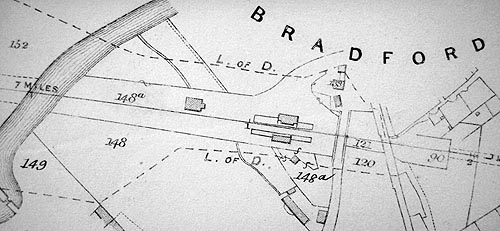
The
proposed Plan of the Railway layout updated by the Great Western Railway
in 1854
1856
On 21st July 1856 the "Wiltshire Times" reported the fall of a wall near the line of the railway, killing one workman and so injuring another that he was not expected to live.
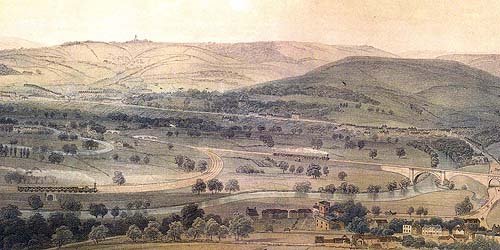
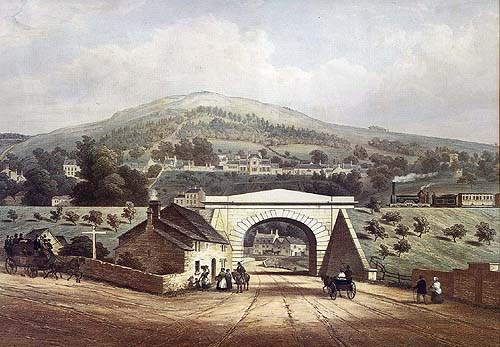
1857
On Monday last the line between Trowbridge and Bath via Bradford was opened for traffic The first train arrived here soon after 7.00 am and 10 trains are registered to run, viz 5 up and 5 down. Considerable excitement prevailed throughout the day, on the arrival of each train the railway station was besieged by hundreds of eager spectators. The celebrated Bradford brass band played lively airs at intervals during the day, and as often as might be heard the sound of the merry church bells. A good dinner was provided in the evening by Mr J,C. Neale of the Swan Hotel. We learn that the inhabitants of the town are not contented with the list of fares laid down by railway company; for a return ticket from Bradford to Bath a distance of 9 miles, a fare of 3/3d is demanded, whereas from Trowbridge to Frome, a similar distance, the price is only 1/6d. The line curves away from the main about on mile from Trowbridge station through Bradford, Avoncliff, Freshford, Limpley Stoke to the junction at Bathampton where it joins the GWR to Bath etc., passing 3 times under the Kennet and Avon Canal and 6 bridges by extensive viaducts over the river Avon.
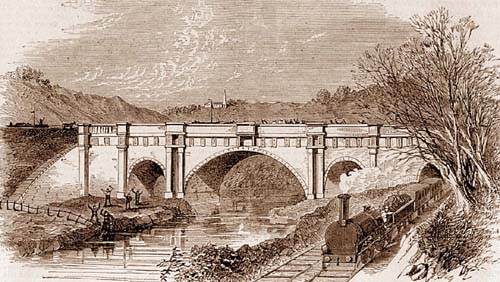
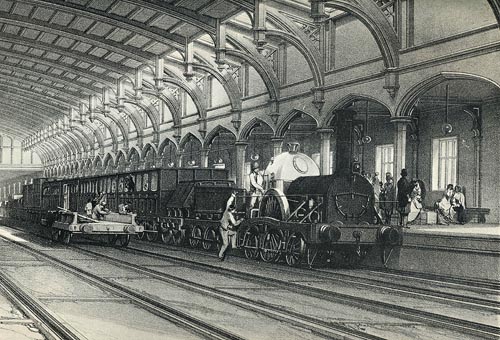
A
Firefly similar to that seen at Bradford on Avon in 1857 here depicted
by Bourne at Temple Meads Station in Bristol.
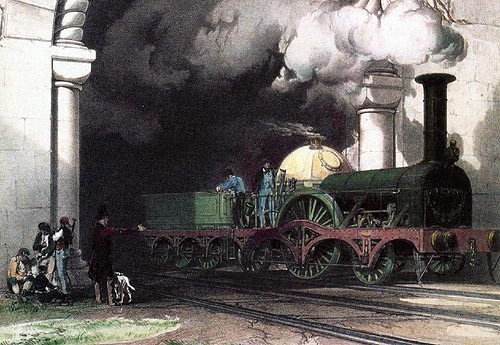
A
Firefly
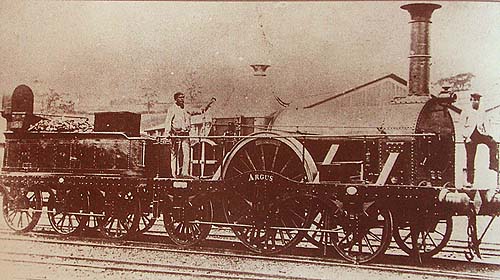
A
Firefly Locomotive,designed by Daniel Gooch were amongst the first locomotives
to be seen on the Bradford line.
Bradford.
On Monday 22nd this unusually quiet town was greatly enlivened by an excursion train which stopped at the Bradford station on its way to Weymouth. Here it was joined by the brass band belonging to the town, to whom great credit is due to for the very praiseworthy way in which they enlivened the pleasure of the day. The weather was remarkably favourable but a goodly number of passengers (150-200) found difficulty in obtaining seats and it would have been easier if rail carriages had been awaiting the train, and it would have been given greater satisfaction.
Another Wiltshire Times news item reports that:
On July 25 1857 Excursion Train
Yesterday morning a monster train from Bristol, Bath and Bradford passed our station on its way to Salisbury. It consisted of about 30 carriages, propelled with two powerful engines. The train was a very heavy one and must have conveyed about 2,000 persons. Our
neighbours at Bradford a short time ago expressed themselves to be annoyed with the accommodation they received on an excursion to Weymouth, on this occasion they have been preferred. However, many persons from Trowbridge we believe availed them selves of the privilege by obtaining tickets at Bradford.
The whole route from Bradford junctions to Bathampton was constructed for a double track but from Barton Farm in Bradford to Bathampton only a single track was laid. It seems irrational after all the effort to drive double tunnels under the Kennet & Avon Canal.
From Bradford Junctions, where the branch leaves the Chippenham to Trowbridge line to Bradford, the double track consisted of Brunel`s original design of rails laid on continued baulks of timber, with transverse wood transoms at intervals. From Bradford to Bathampton the rails were laid on cross sleepers, similar to today's track except that the sleepers were spaced at 3 ft intervals.
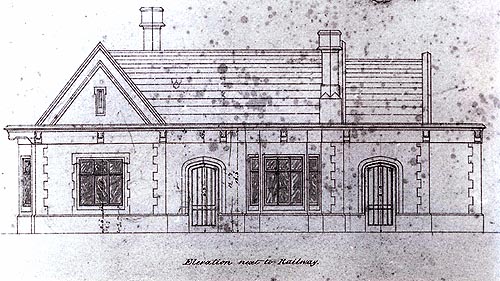
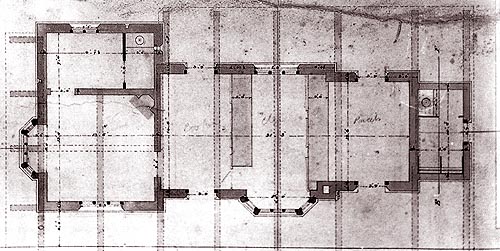
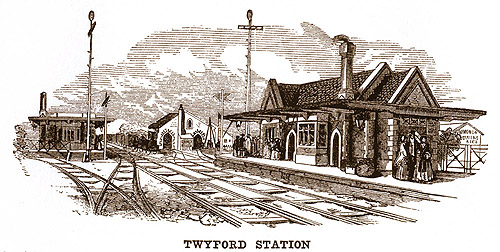
A
view of Twyford Station in 1852 which is almost identical to that of Bradford
on Avon with its Goods Shed in the background and Passenger Shelter on
the left.Sadly all these buildings disappeaerd with the quadrupling of
the track to Standard Gauge in 1892.
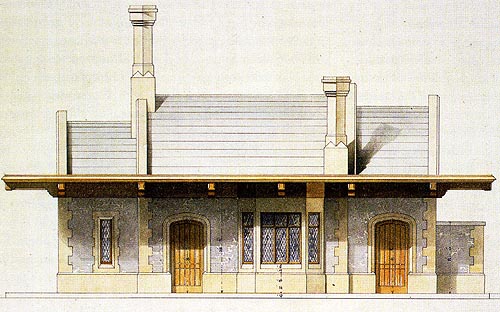
The
following 3 drawings are the 1843 contract drawings for Culham station
designed by Brunel. They are almost the same as those for Bradford apart
from a Gable that was added to this station.
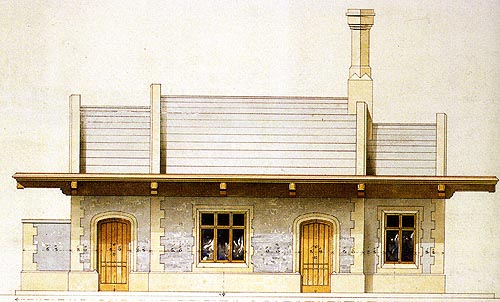
Culham Station (ii)
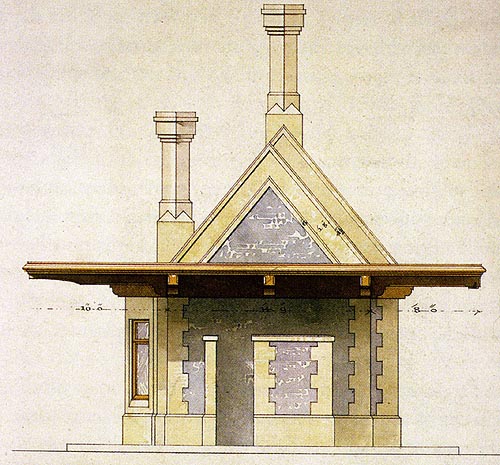
Culham Station (iii)
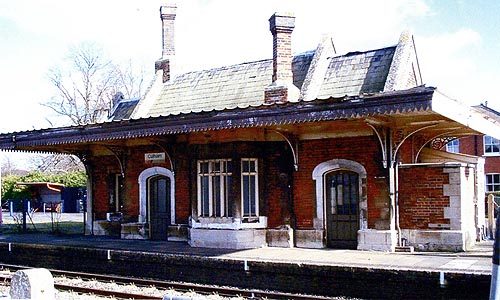
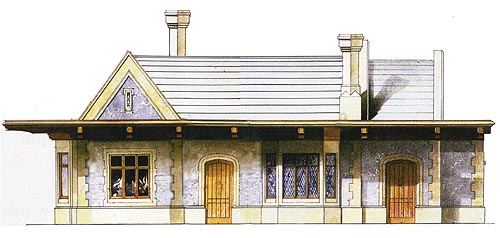
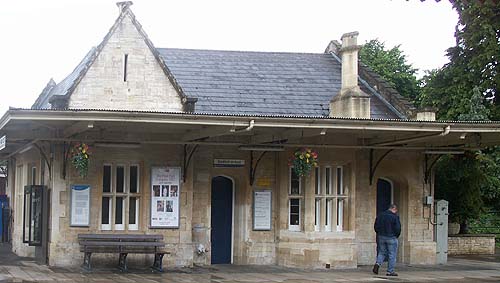
The
same view of the Station at Bradford on Avon today
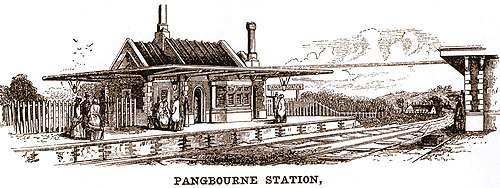
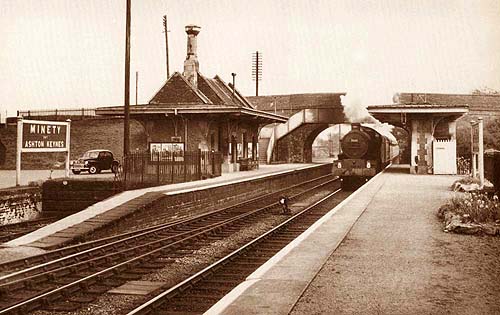
Minety
Station
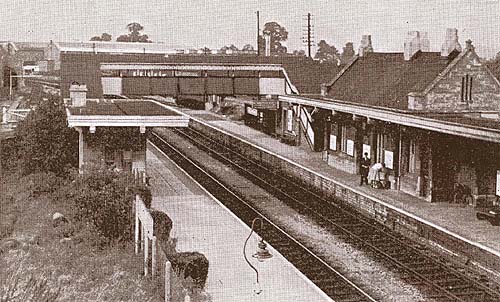
Melksham
Station
The style is similar to the Elizabethan/Jacobean style used by architects like Edward Blore and Anthony Salvin for many of their country houses of this period. Apart from the canopies, the stations could easily serve as lodges or estate houses to one of these grand country estates.
From Brunel`s sketches, the detailed plans were drawn up by his assistants. The names of J. Geddes, I. Nolloth and F. Prinsit have been recorded as assistants in 1848, but it is not known which worked on Bradford. Geddes and Nolloth were responsible for the station at Melksham, with a somewhat similar design to Bradford
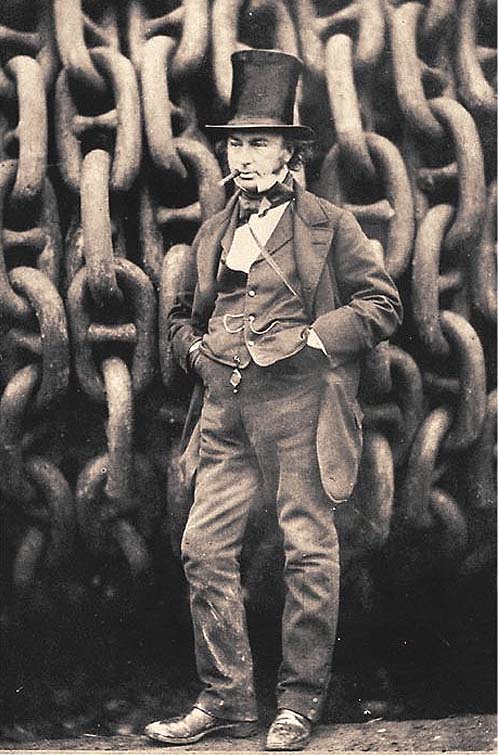
1859
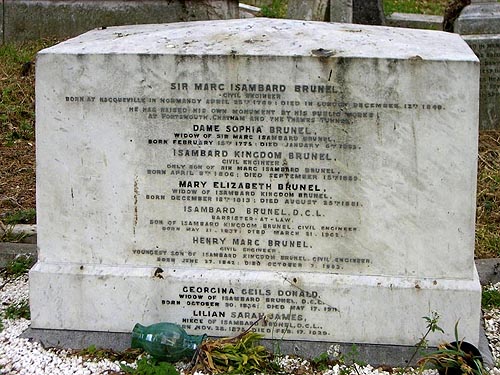
The
Brunel Family Tomb at Kensal Green Cemetery in London
1861
"The facilities afforded by this company (GWR) for trips to this favourite watering place have induced thousands to avail themselves of the facilities offered. On Monday last an excursion train of 22 carriages containing 850 passengers arrived from Bath and Bristol."
Later on the 29 August it wrote:
"For the last few weeks, the excursion trains have brought into the town several thousands of visitors and although their stay in many cases is of very short duration, the lodging houses are pretty nearly always full."
Many of these travellers would pass through Bradford on their way to Weymouth. The railway gave cheap, speedy travel and Weymouth boomed with this new trade.
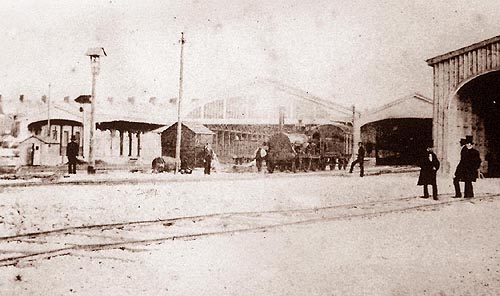
An
early photograph of Weymouth Station in 1857, the year of its opening.
1870
1871
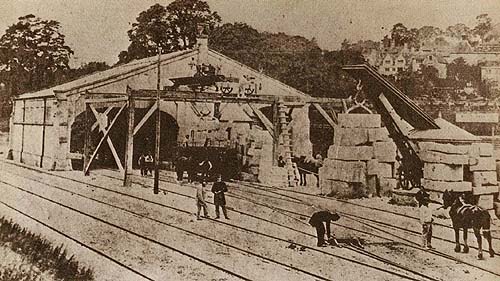
1872
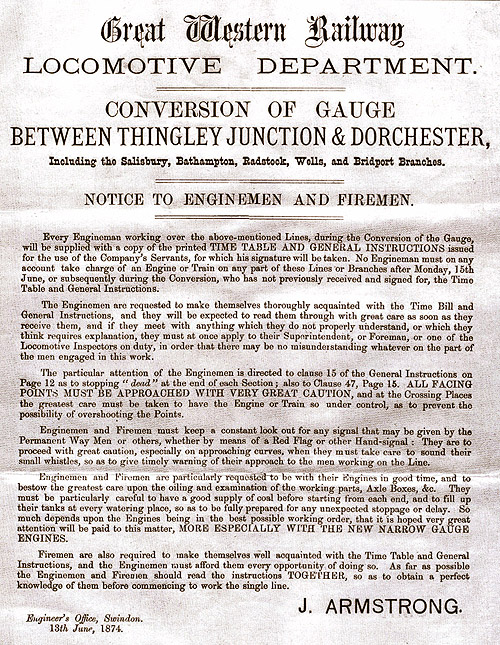
Notice
concerning the Conversion from Broad Guage to Standard in 1874
1874
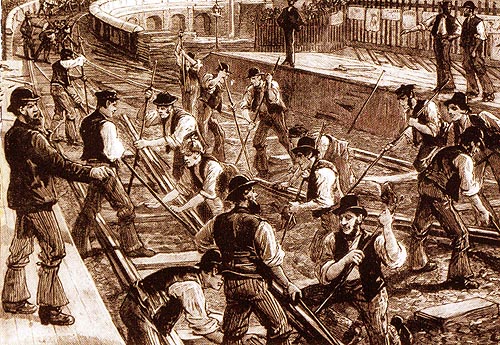
Conversion from Broad Gauge to Standard in 1874
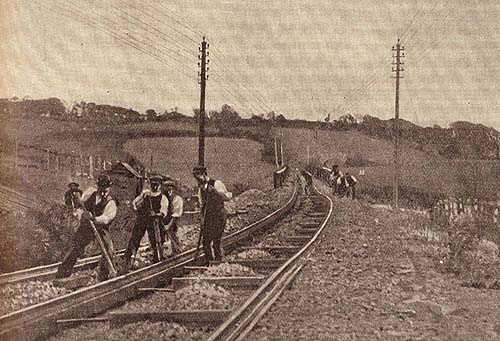
Work continued from dawn to dark, about 18 hours each day. The GWR provided sheds for the men and straw to sleep on; smoking and drinking spirits were forbidden. The workmen were paid off on 26th June, two special trains conveying them back.
On 21st June nine long trains of standard gauge carriages were brought in from Swindon. Normal services were resumed with the end of the Broad Gauge era.
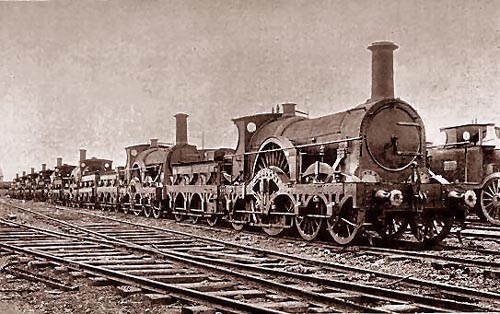
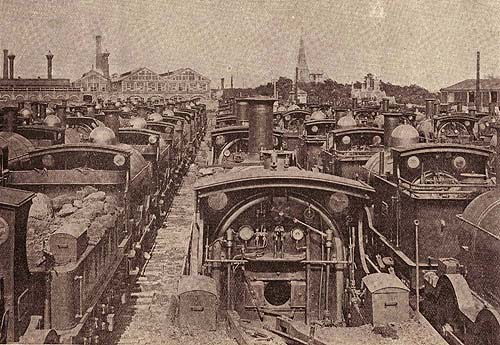
Redundant
Broad Gauge Locomotives at Swindon
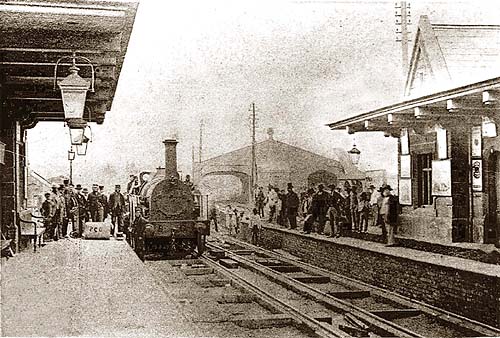
1875
1877
1878
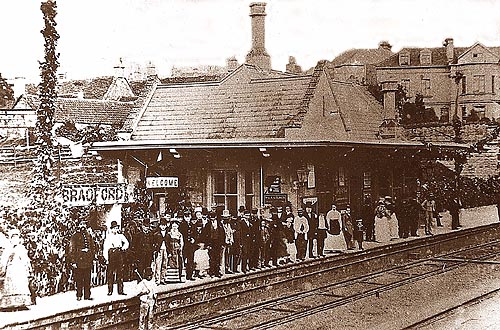
1885
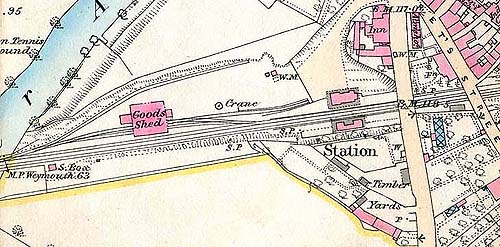
Ordnance
Survey map of 1886 showing the layout of tracks and buildings at Bradford.
1886
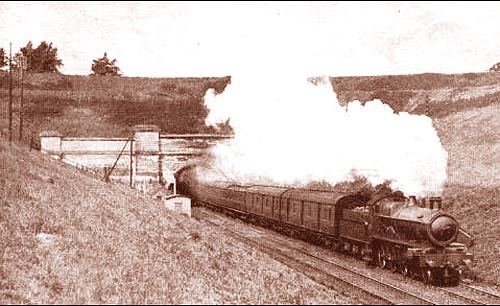
1887
1888

Advert
for F. B. Noris of Bradford on Avon. c.1890.
1895

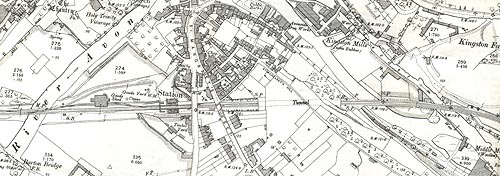
The
1901 O/S map showing the tunnel and bridges over roads and the river that
were needed.


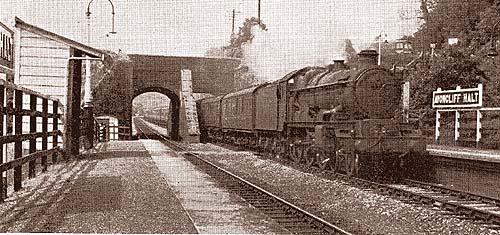
Avoncliff
Halt near Bradford on Avon
1906

1914
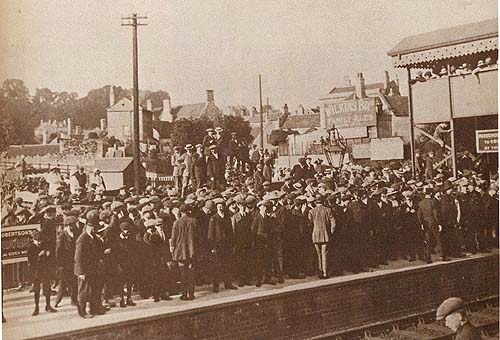
At
first service in the armed forces in the First World War 1914-1918 was
voluntary and any firms encouraged their employees to "join up".
In this picture we see workers from Spencer Moulton's giving volunteers
from the firm a big send-off from Bradford railway station.
1920
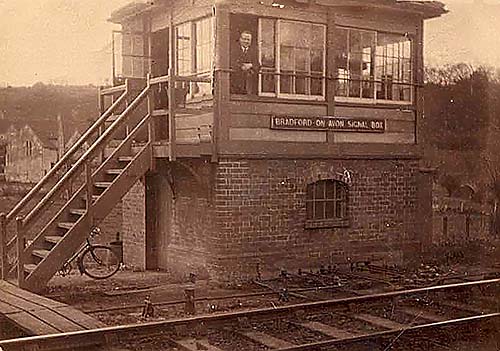
Bradford-on-Avon
Signal Box, c. 1920. This is a photograph of the signal box that controlled
the goods yard at Bradford-on-Avon.
1923
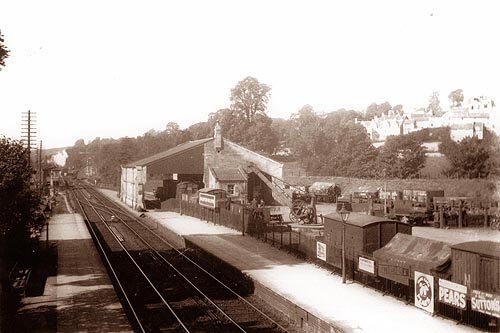
This
photograph of the Goods Shed and yard taken from the Passenger bridge
in 1926 by H.C.Casserley
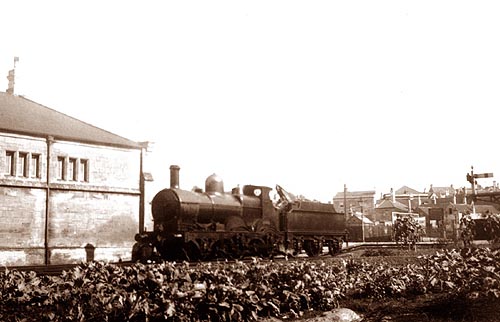
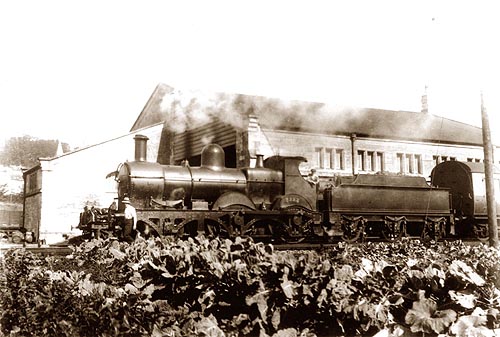
Similar
to above
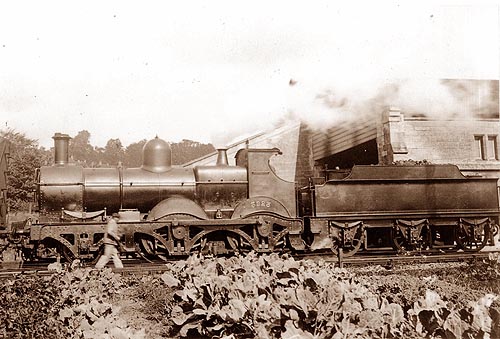
Similar
to above
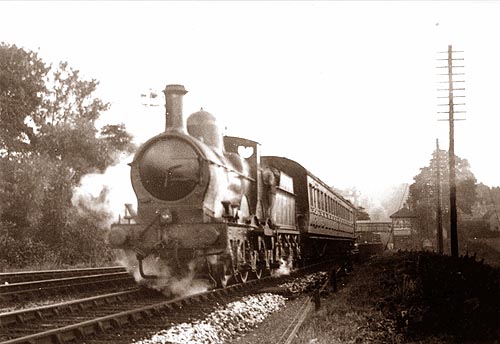
Similar
to above
1928
The
Great Western Railways 4900 Class or Hall Class is a class of 4-6-0 mixed
traffic steam locomotives designed by Charles Collett often to be seen
in photographs of Bradford Station in the 1950` and 60`s.
1939-45
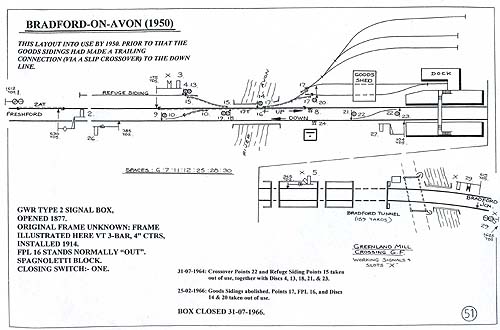
1948
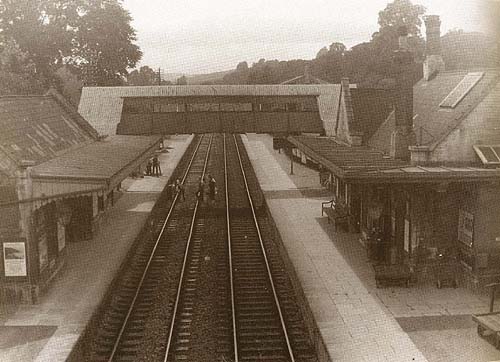
A
view from Frome Road Bridge of the Station in the 1930`s
The Western Region built a large number of steam locomotives to GWR designs, even after the advent of diesel shunters. The BR standard class 3 was also built for the Western Region.
The Region experimented with diesel hydraulic traction such as the British Rail Class 52 Westerns and British Rail Class 35 Hymeks based on West German designs; these were all eventually replaced with British Rail national standard diesel electric classes.
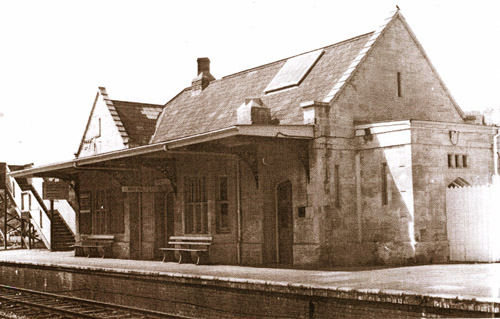
Bradford
on Avon Station c.1960 . Note the stone Chimneys removed and partly rebuilt
in brick.




The
rebuilding of Barton Bridge over the Avon in 1960
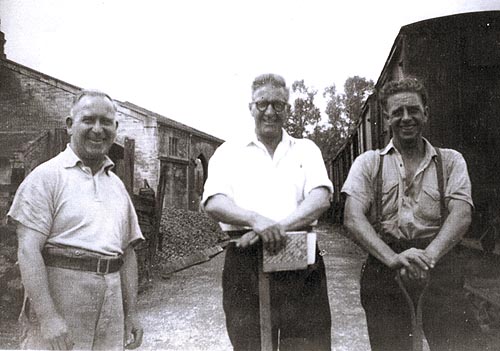
Workmen
in the Goods Yard with the Old Goods Shed in the background (demolished
1966)
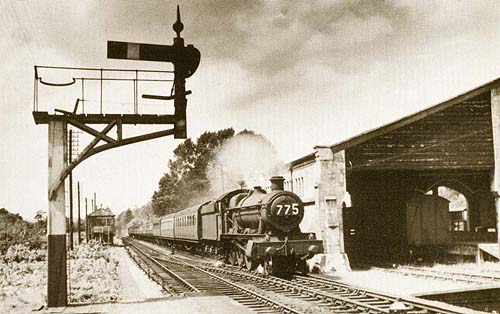
No.6958
"Oxbury Hall" passing the Goods Shed in 1951
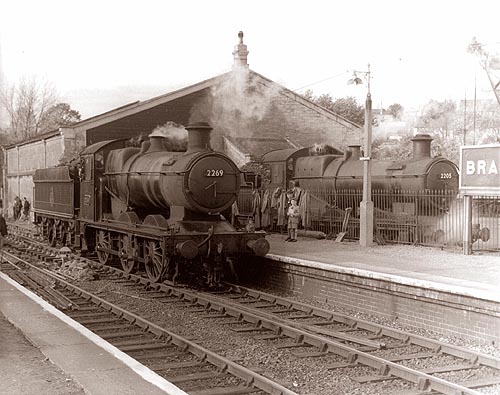

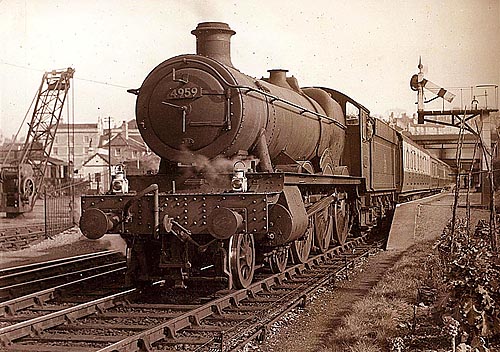
no.
4959 Purley Hall, built in 1929 at Swindon.The first shed allocation was
at Westbury. Notice the rare glimpse of the Crane in the Goods Yard, now
the Station Car Park. It was withdrawn in December 1964 and scrapped at
Buttigieg's, Newport.
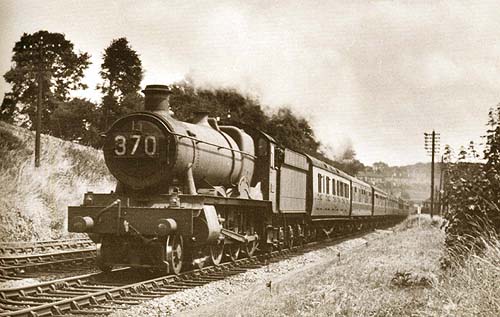
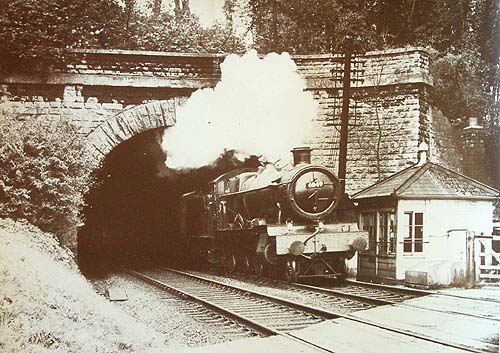
6849
"Walton Grange" with a Sunday parcel train emerging from the
tunnel by Greenland Mill Bradford
on Avon in 1961. The Greenland Mill signal box disappeared when the Level
crossing was fitted with automatic barriers in November 1966
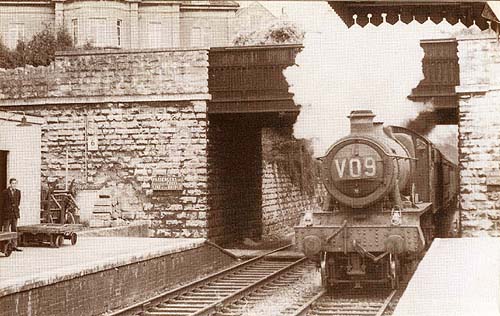
A
Hall class 4-6-0 passing under Frome Road Bridge in 1962
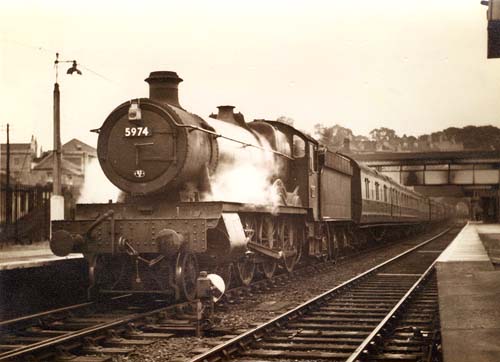
Wallworth
Hall (4-6-0)at the up platform, with a down train, at Bradford on Avon
on 11th September 1955eptember 1955.
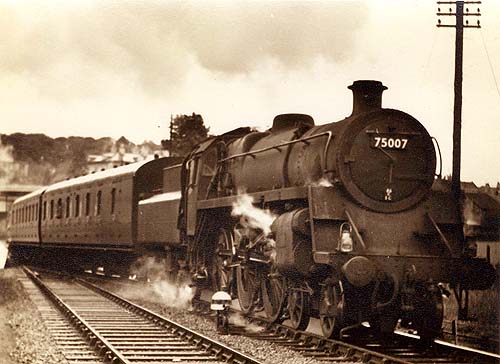
Standard
Class 4MT 4-6-0 no.75007 (85c) crossing over the up road to the down road,
at Bradford on Avon on the 11th Sptember 1955.
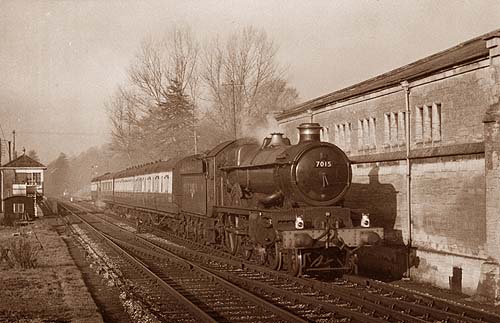
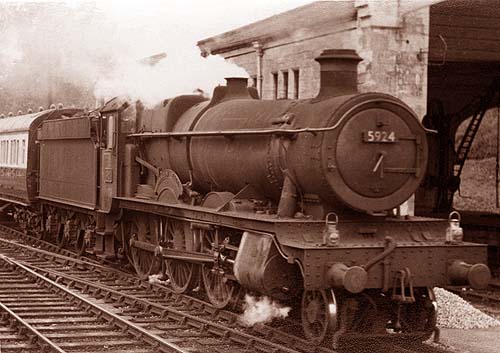
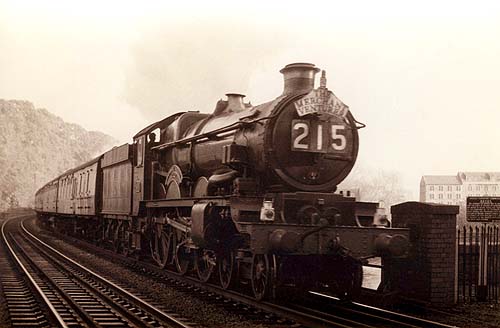
A
Castle Class 4-6-0 at Greenland Mills crossing. The train is the "Merchant
Venturer" diverted from Chippenham via Melksham, Holt Junction, Bradford
Junction and Bradford on Avon to Bath, then on to Bristol Temple Meads
and Weston Super Mare.
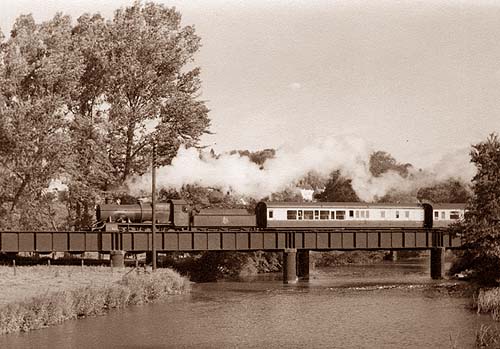
A
local train hauled by a 2-6-0 locomtive crossing the River Avon at Bradford
on Avon on Barton Bridge over the River Avon.
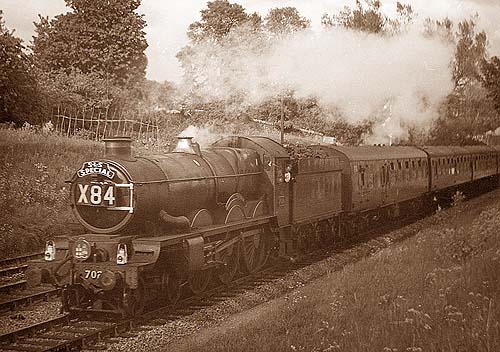
Castle
Class 4-6-0 No. 7029 Clun Castle train 1X84 an excursion organised by
the Stephenson Society passing Bradford on Avon. Note the Railwayman`s
allotment in the background.
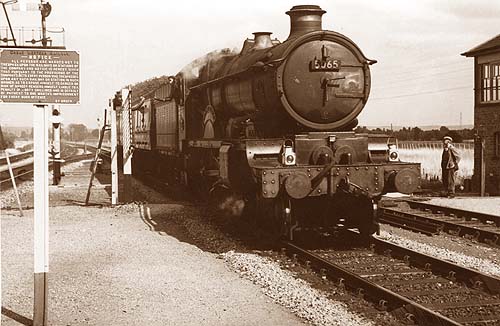
5065
Newport Castle. Originally built as Upton Castle, July 1937. withdrawn
January 1963. Scrapped at A. King & Son, Norwich.This photograph taken
on the 9th September 1961 shows it hauling the down "Torbay Express",
not carrying the headboard, at Holt Junction. The fireman is putting the
single line token for the Devizes branch on the hook.
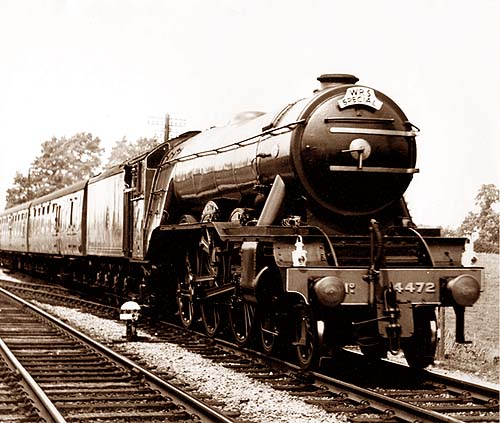
No.4472
Flying Scotsman at Bradford Junction hauling a Warwickshire Railway Society
Special.
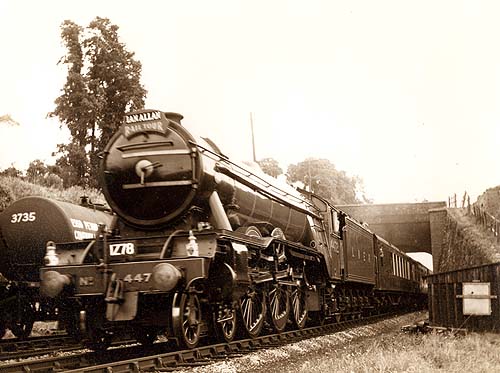
No.4472
Flying Scotsman passing under the Aqueduct carrying the Kennet and Avon
Canal, at Avoncliff hauling 1278 an Ian Allen Rail Tour which came via
Devizes, Bradford Junction and Bradford on Avon.
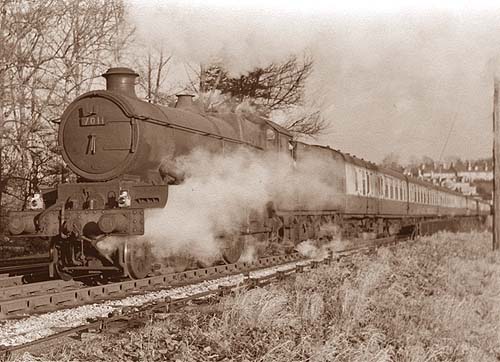
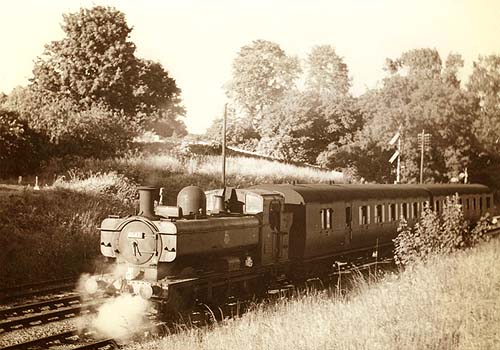
no.
4647. built 1943 at Swindon and was withdrawn in 1962. The '5700' (0-6-0)class
of light goods and shunting engines were the largest of any one class
produced for the GWR totalling 863 engines. It is shown here between Bradford
on Avon and Avoncliff.
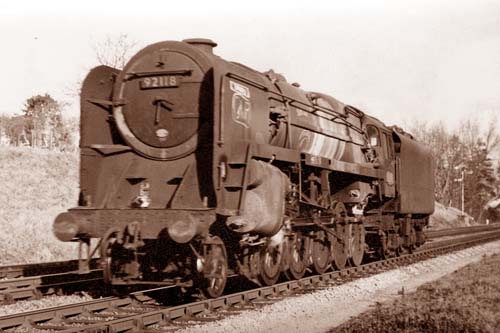
A
2-10-0 9F freight Locomotive no. 92118 running light through Bradford
on Avon towards Bath.

A
Castle Class 4-6-0 at Greenland Mills crossing. The train is the "Merchant
Venturer" diverted from Chippenham via Melksham, Holt Junction, Bradford
Junction and Bradford on Avon to Bath, then on to Bristol Temple Meads
and Weston Super Mare.
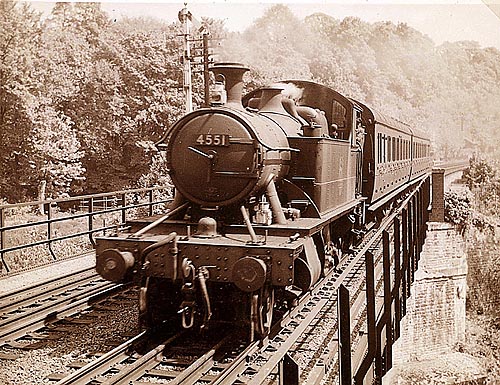
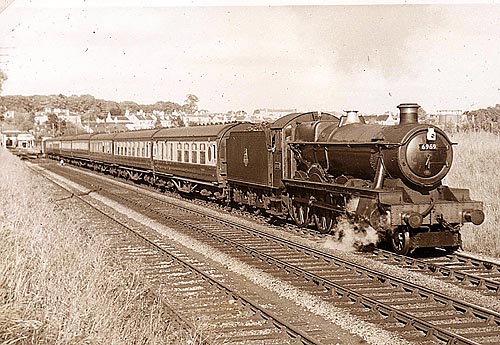
4968
Shotton Hall was built at Swindon in 1929. The last shed allocation was
Bristol, St. Philip's Marsh and was withdrawn in July 1962 and scrapped
at Cashmore's, Newport. It is shown here leaving Bradford on Avon Station
en route to Bath.
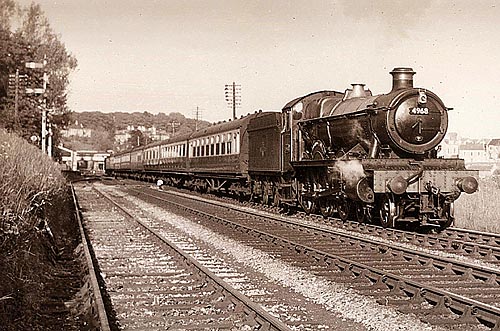
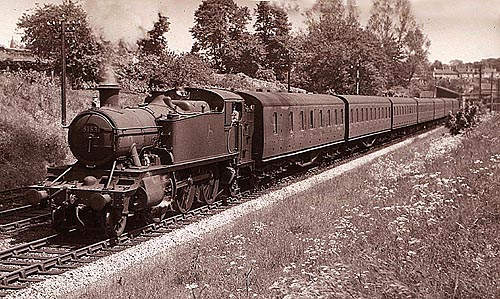
The
no. 6168(2-6-2) was built in 1935 and withdrawn in 1962 . It is shown
here leaving Bradford on Avon Station.
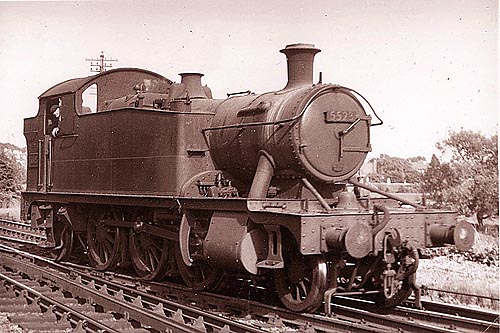
GWR
Tank Engine no. 5523 at Barton Farm, Bradford on Avon

4968
Shotton Hall was built at Swindon in 1929. The last shed allocation was
Bristol, St. Philip's Marsh and was withdrawn in July 1962 and scrapped
at Cashmore's, Newport. It is shown here leaving Bradford on Avon Station
en route to Bath.
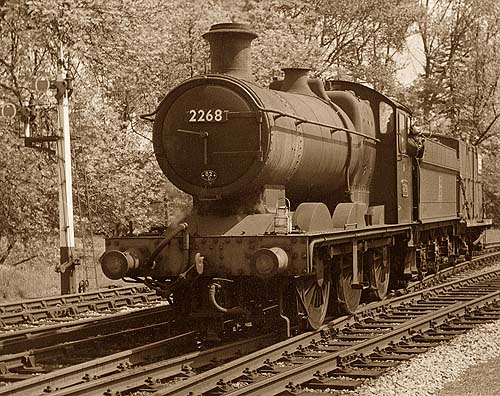
Collett
Class 2251 3MT 0-6-0 2268 (82D - Westbury) crossing
over from the down line to the upline so the container wagon could be
deposited in the goods yard( note the sidings signals).
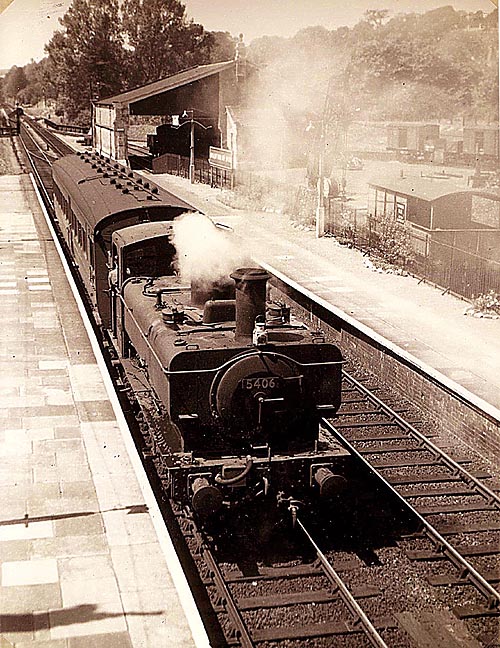
A
GWR Pannier Tank 5406 in Down Platform on 1 Coach Auto Train. The Goods
Shed and Yard can be clearly seen in the background.
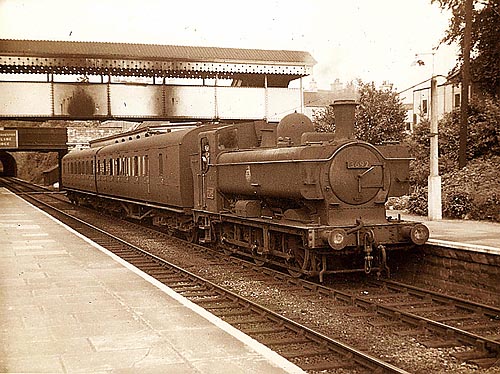
GWR
Pannier Engine no. 3692 on down line, 2 coach train at Bradford on Avon.
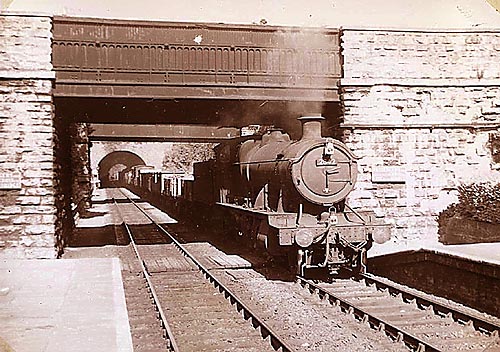
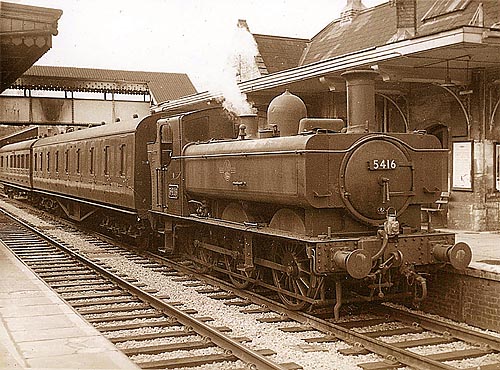
The
GWR Pannier Tank Engine in Bradford on Avon station built
in 1932, Most of the '5400' class had been withdrawn by 1960 due to the
introduction of the diesel railcar. It was to be immortalised by the Rev.
Awdry as "Duck" in the tales of Thomas the Tank engine
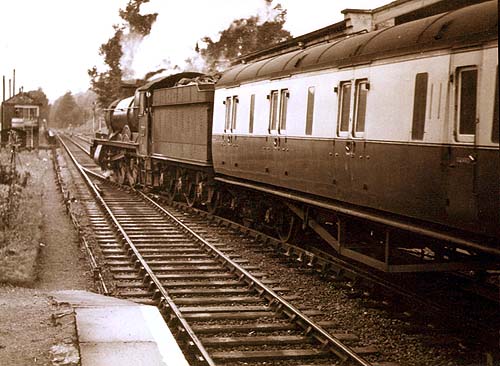
Wallworth
Hall (4-6-0) crossing from the up road to the down road at Bradford on
Avon on 11th September 1955.
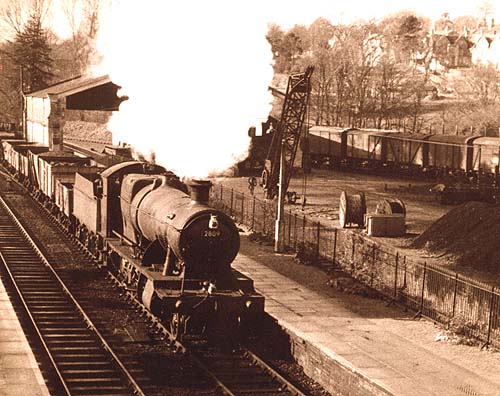
No.
2908 ( class 2-8-0) was built in 1905 and was withdrawn in 1960. It is
shown here at Bradford on Avon by the Goods Yard, now the Station Car
park
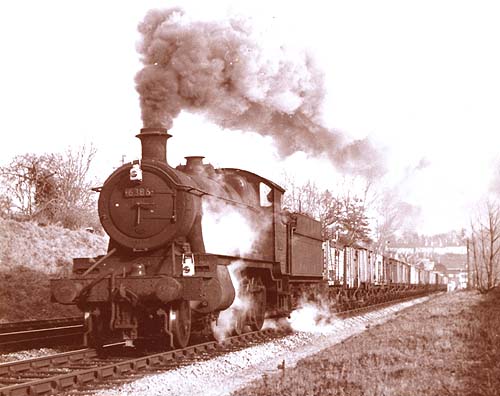
Churchward
design 2-600 4300 Class 4MT No.6386 passing Bradford on Avon with a down
freight. This locomotive is leaking plenty of steam from various places
but is still doing a grand job, going well..
1961
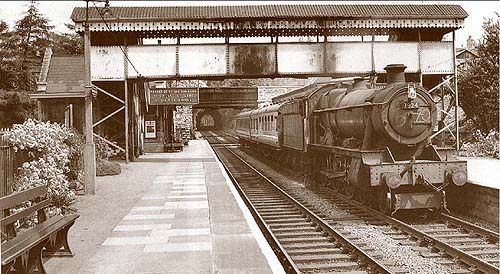
No
7024 "Thornycroft Hall" arriving in Bradford with a Salisbury
Train in 1963
1963
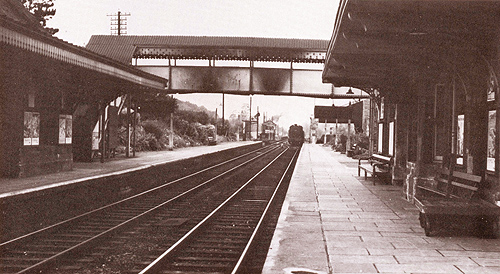
Bradford
on Avon Station c.1960
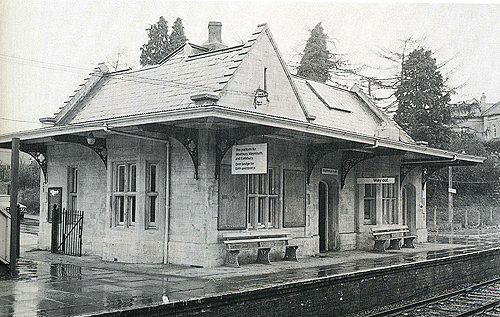
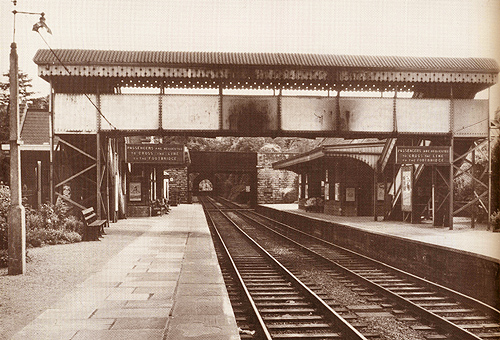
Bradford
on Avon Station in 1963
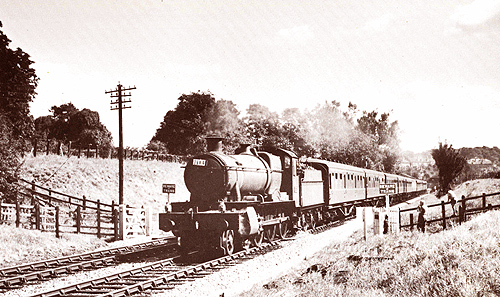
No.
7829 Ramsbury Manor leaving Bradford on Avon in 1964
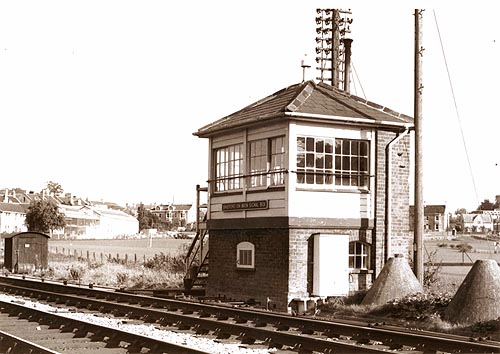
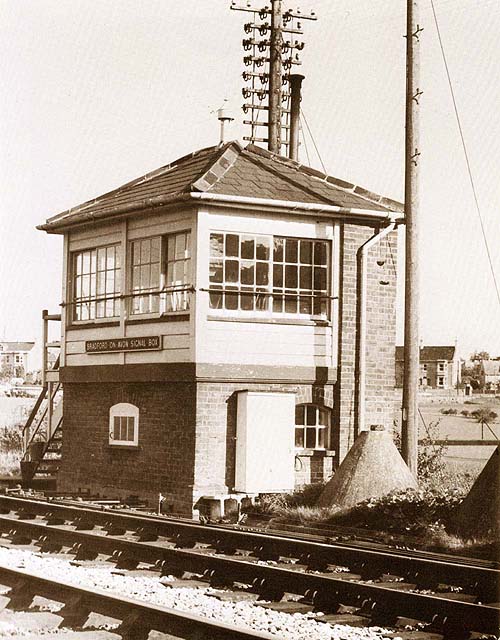
The
Signal Box near Barton Bridge, demolished 1966 with the second world War
Tank emplacements alongside which are still to be seen.
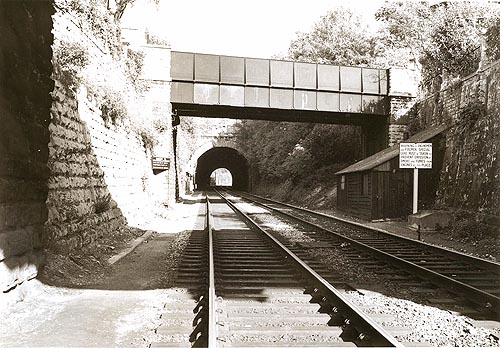
Trowbridge
Road Bridge in 1962 with tunnel in distance and workmans cabin on the
right.
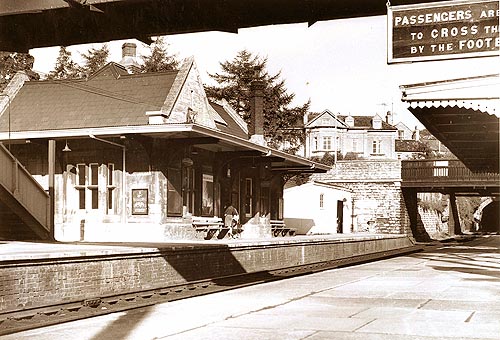
Station
in 1962 with Frome Road Bridge and tunnel in distance
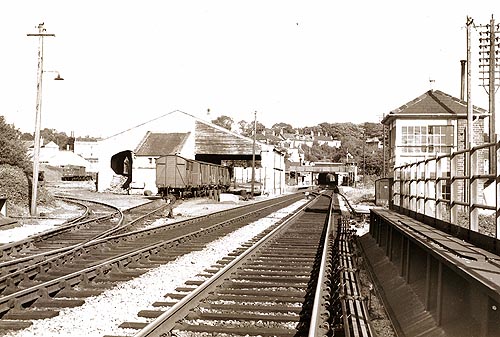
The
Goods Shed and Yard with the Signal Box on the right in 1962
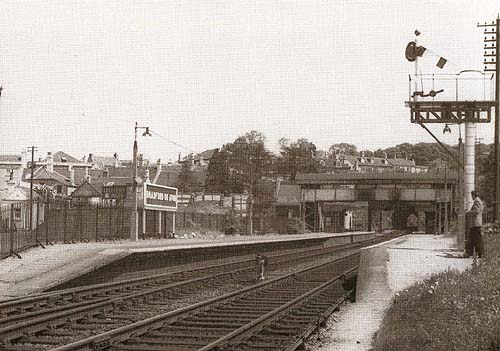
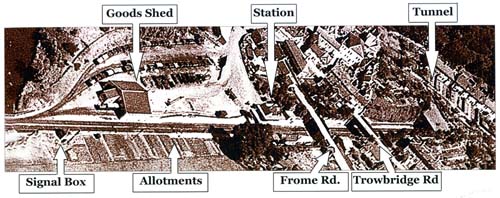
1964
1966
Dr. Beeching, chairman of I.C.I. who had been appointed by the government to investigate and recommend a plan for the future of the railways, presented his report. It proposed the closing of many branch lines, leaving large parts of the country without a connection to the railway. It had been evident for years that the growth of motor transport was taking traffic from the railways, just as they had done from the canals, but the severity of the cuts came as a shock. Maps accompanying the Beeching Report showed that passenger traffic on the Bathampton - Bradford-Trowbridge-Westbury line was about 50,000 passengers per week and that Bradford on Avon's ticket sales were between £5,000 and £25,000 a year. Freight traffic was given as about 50,000 tons per week, with less than 5,000 tons a year being loaded or unloaded at Bradford on Avon. Beeching recommended that the line should remain open, but that passenger services be modified.
1967
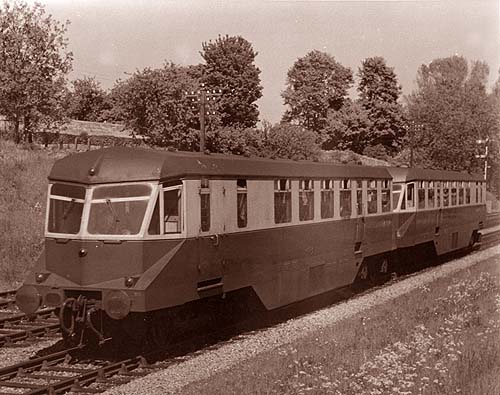
These sets sometimes had a coach sandwiched between them and were used between Bristol Temple Meads to Weymouth and return. this was the afternoon return service from Weymouth.
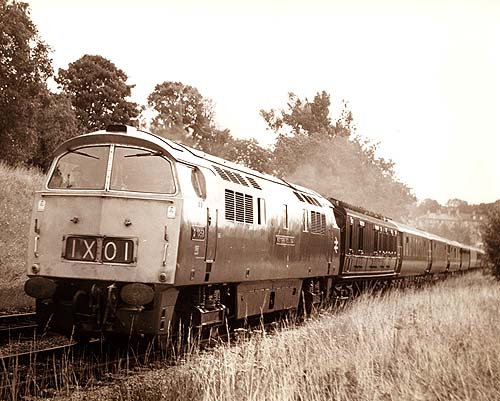
The
Royal train conveying HM the Queen and Prince Philip from Staverton (
where they spent the night) to Bath, at Bradford on Avon on 9th August,
1973. The Locomotive is no. 1058, Western Nobleman.
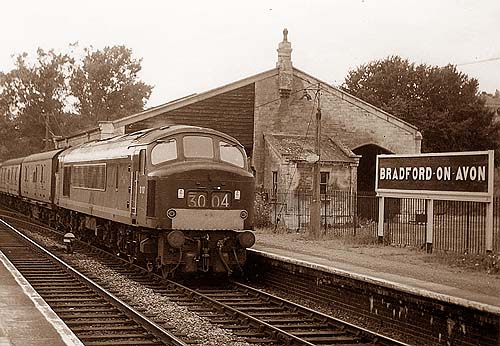
Peak
Class 4 ICO - COI no. D87? train 3004 parcels Train alongside the Goods
Shed (demolished 1965).
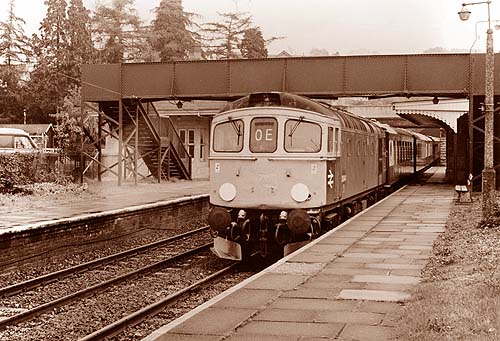
The
"Orient Express" (VSOE) Victoria to Bristol at Bradford on Avon
Station.
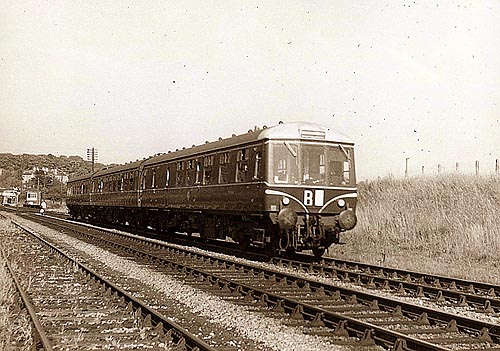
British
Rail Cross Country Diesel, Multiple Unit down at Barton Farm,Bradford
on Avon c.1966.
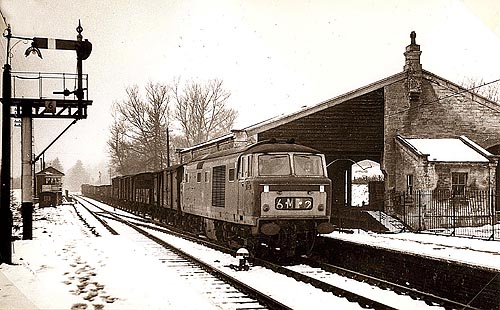
British
Rail Hymek Diesel c.1965 entering Bradford on Avon Station with the Goods
Shed covered with snow in the background. The Signal Box opposite can
still be seen before its demolition in 1966.
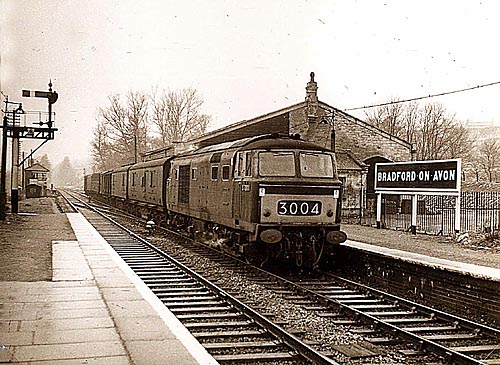
Hymek
Diesel Hydraulic locomotive(D7008), built between 1961 -4, up afternoon
train was seen at Bradford on Avon on 16th April 1964.
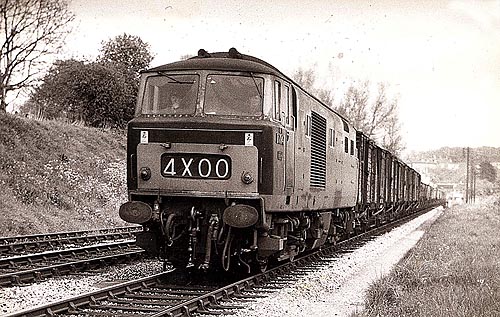
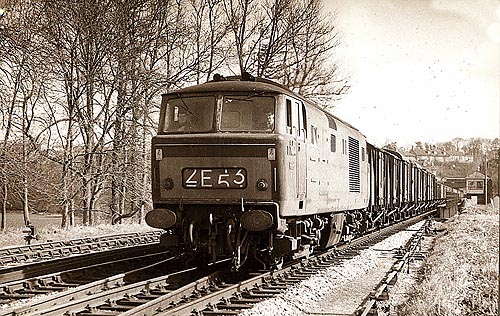
Hymek
Diesel on 2E53 down freight passing Barton Farm with the signal box in
the distance.
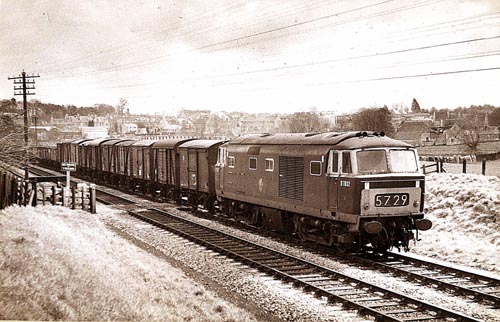
Hymek
Diesel Locomotive(5729) with freight passing Barton Farm in Bradford on
Avon.
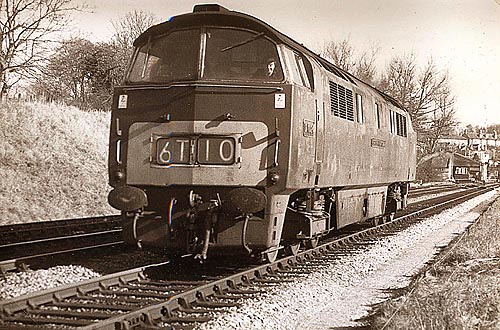
"Western"Diesel
D1024 GT10 light engine passing Barton Farm with Bradford on Avon Station
in the background.
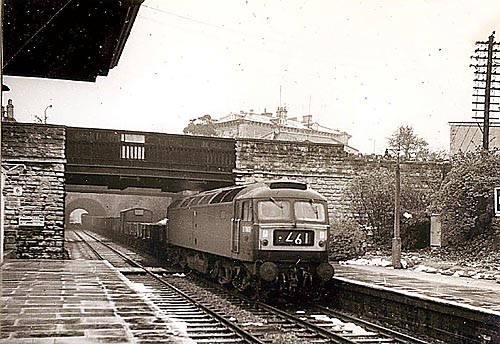
D1909
down Brush Type 4 Diesel(Z61) with mixed freight going under Frome Road
Bridge as it enters Bradford on Avon Station the 16th April1966.
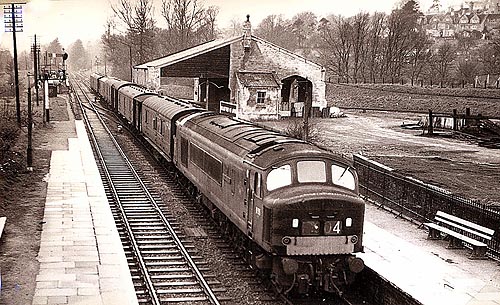
The
up afternoon Parcels train in Bradford on Avon Station with the Goods
Shed in the distance c. 1964.
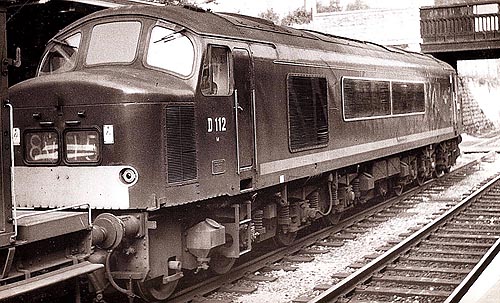
The
British Railway Sulzer Type4 Peak D20 (8V15) at Bradford on Avon Station
in 1967.
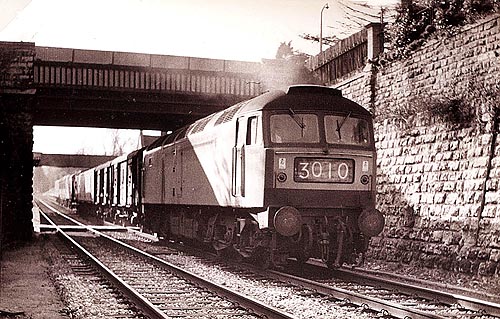
Parcels
Train leaving Bradford on Avon for Trowbridge going under the Trowbridge
Road Railway Bridge.
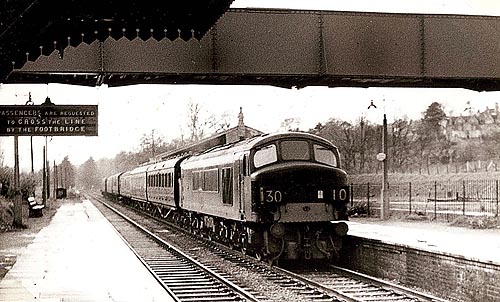
British
Railways 3010 Class 44 or Sulzer type 4 "Peak" were built between
1959- 1960 at Derby. It is shown on parcels at Bradford on Avon Station
c.1967 .
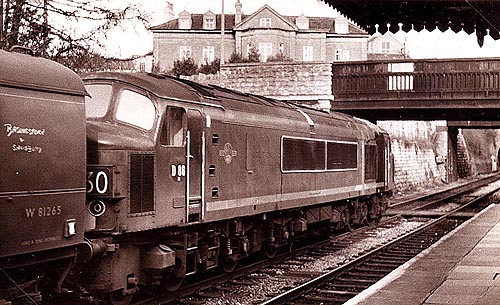
The
British Railway Sulzer Type4 Peak D86 (45105) at Bradford on Avon Station
in 1967. This Locomotive survives at Barrow Hill, Derbys)
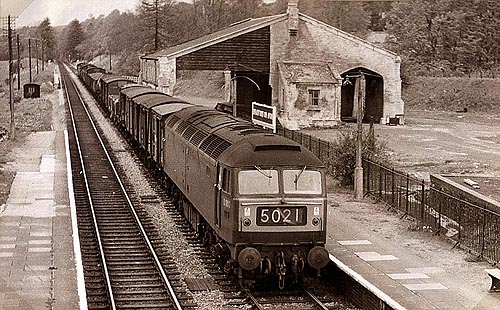
British
Rail Brush Type4 Sulzer Diesel(D1812) in 1967 entering Bradford on Avon
Station with the Goods Shed in the background. The Signal Box opposite
had been demolished by then.
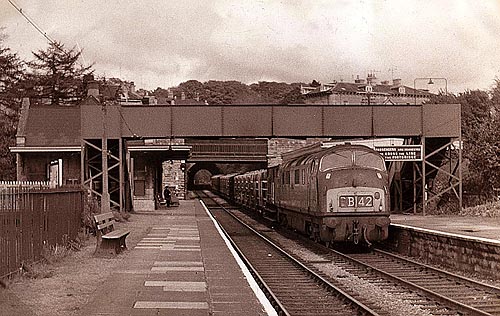
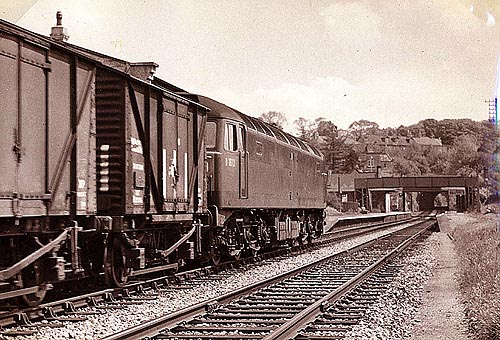
The
Sulzer-engined, Brush Type 4 locomotive (D1613 (47033) pulling freight
in 1967 by Barton Far. This locomotive still survives at Gloucester.
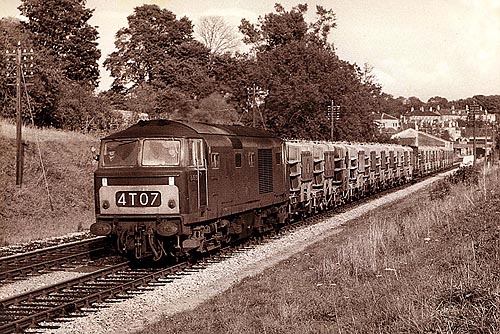
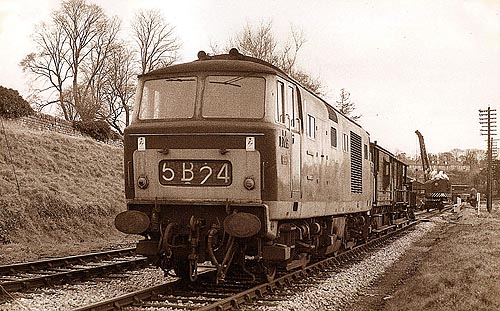

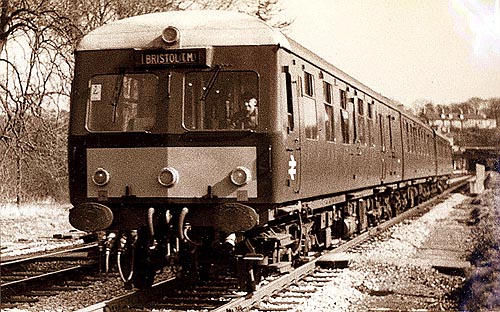
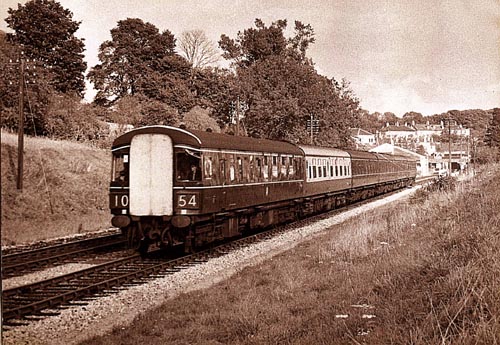
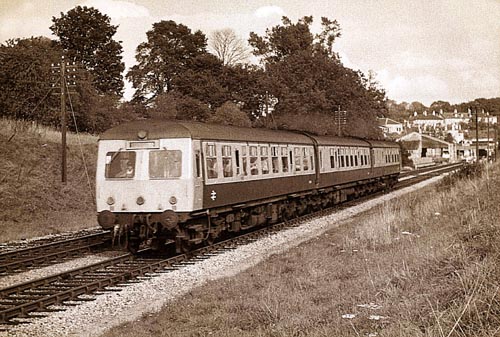
British
Rail 3 car D.M.V. W50650, 59256, 50708 passing Barton Farm on the 22nd
September 1967.
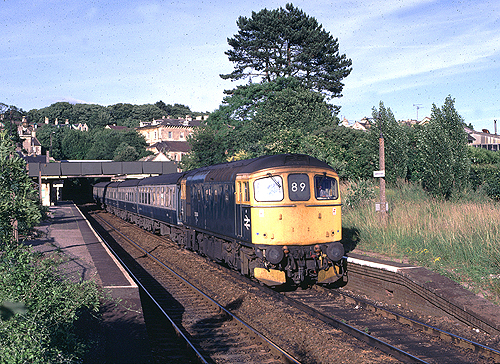
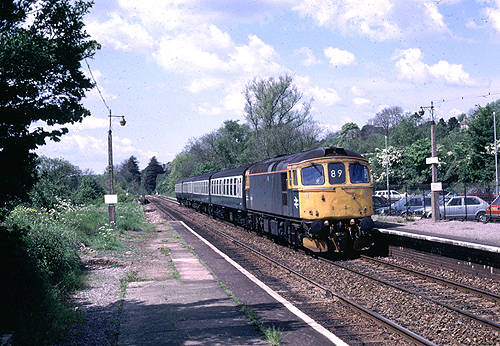
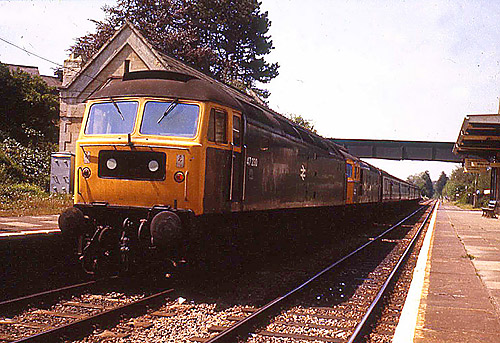
A
Class 47 British Rail Locomotive passing through Bradford on Avon Station
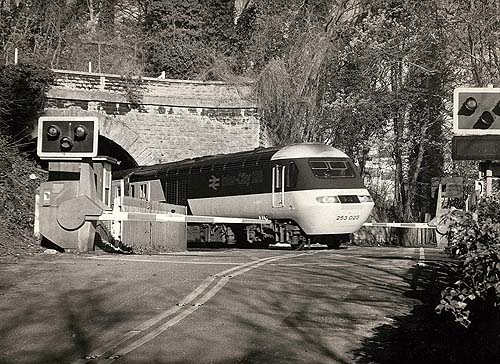
An
HST Locomotive by the Greenland Mill level crossing.
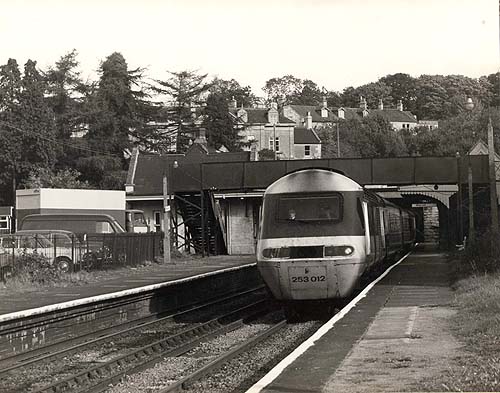
An
HST Locomotive entering Bradford on Avon Station.
1974
1976
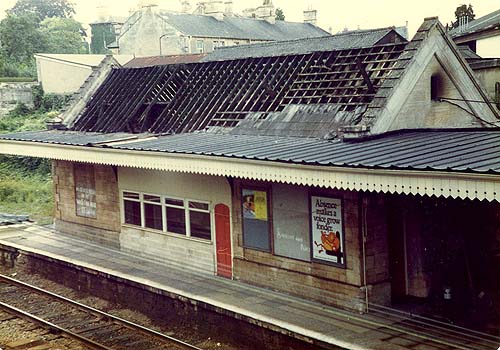
Damaged
roof after an accidental fire during work on the Shelter on August 9th
1980
1984
and Bradford Junction, to be undertaken in early 1986, in connection with saving renewal of much of the worn out jointed track on the route. Following a public outcry and a rethink by British Railway, the plan was dropped in late 1984.
1988
1990
1991
1992
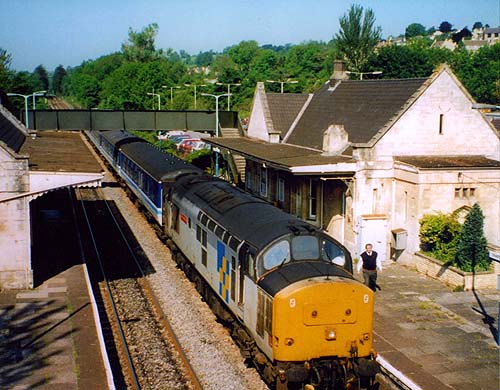
Class
37 no. 37425 Bristol-Weymouth in 1993 with Ron Adams on the platform
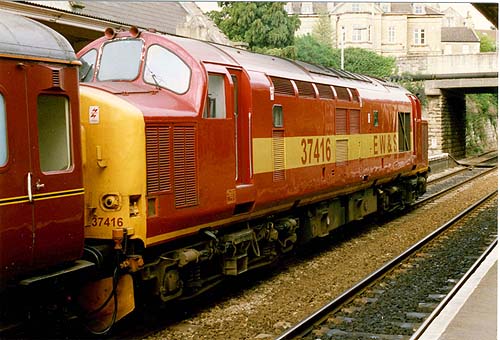
Class
37 no. 371416 at Bradford on Avon with the nsundays only morning train
to Weymouth.
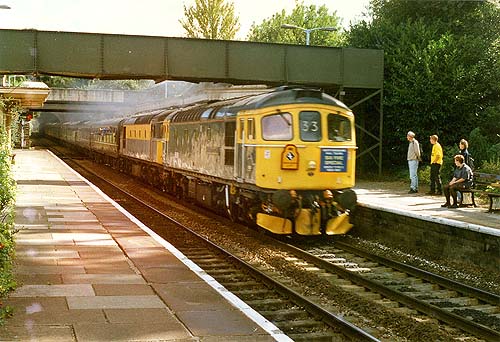
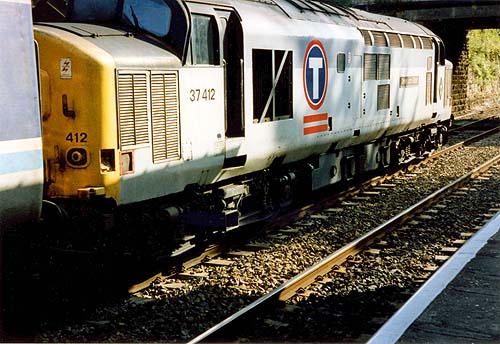
Class
37 no.37412 driver John Elliott with the sundays only, morning train to
Weymouth
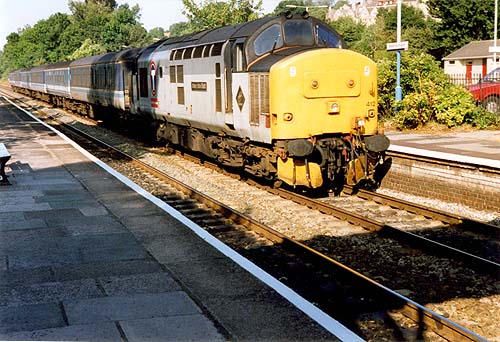
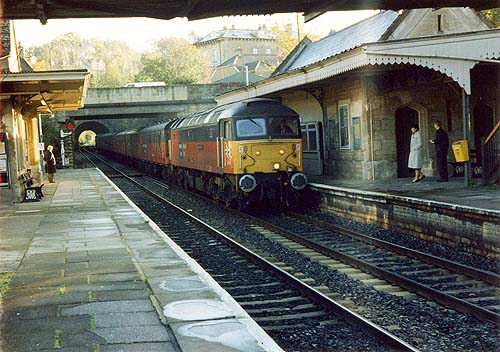
A
diverted parcels train at Bradford on Avon Station.
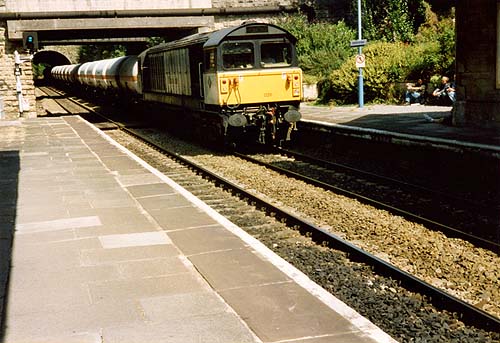
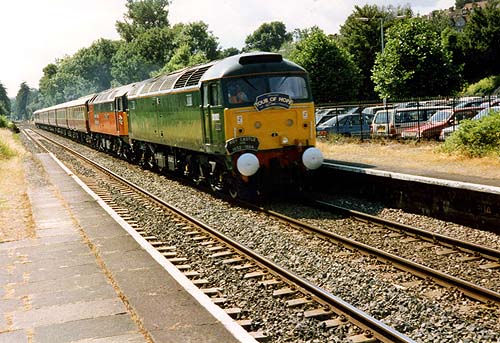
"Roy
Castle Tour of Hope"double headed by 2x class 47 locomotives. This
train travelled round the country. The second locomotive was called "Roy
Castle". Roy Castle suffered from Cancer , from which he later died.
1994
1998
Railings between Station Forecourt and Goods Yard removed. Station refurbished by Rail Track.
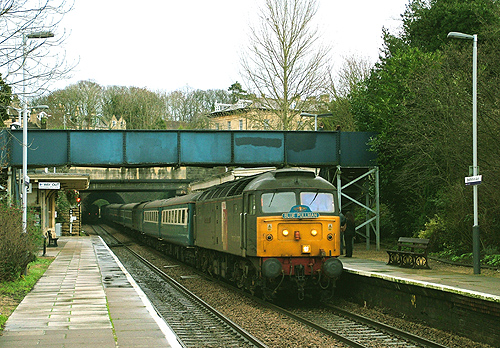
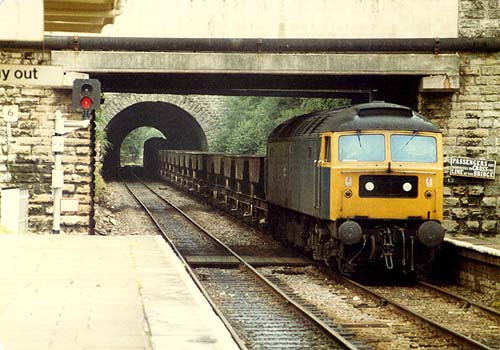
A
Class 47 Locomotive hauling an Engineers train at Bradford on Avon
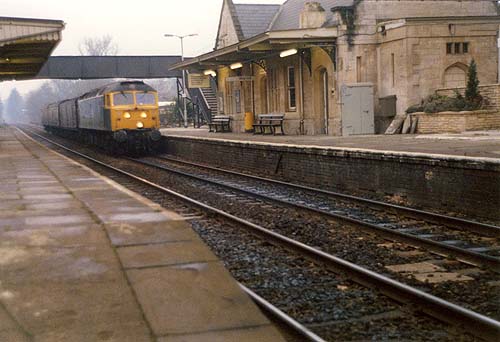
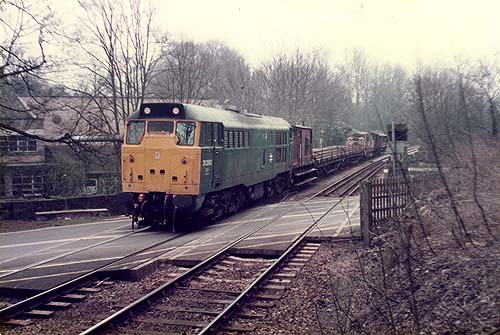
Class
31 no. 31260 running "wrong road" at Greenland Mills crossing
with an engineers train.
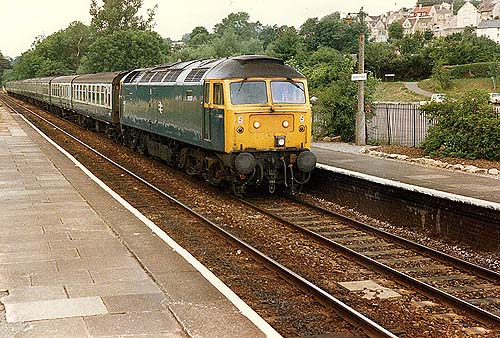
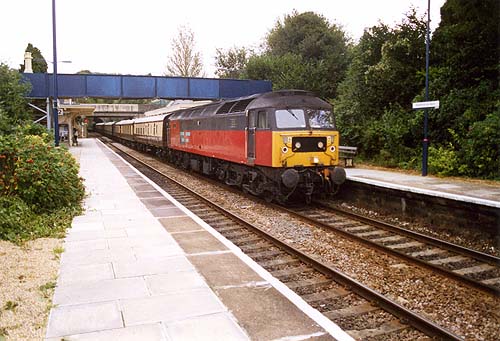
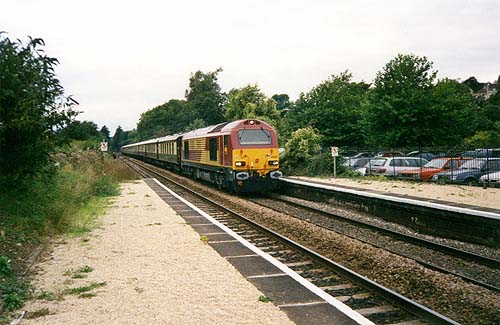
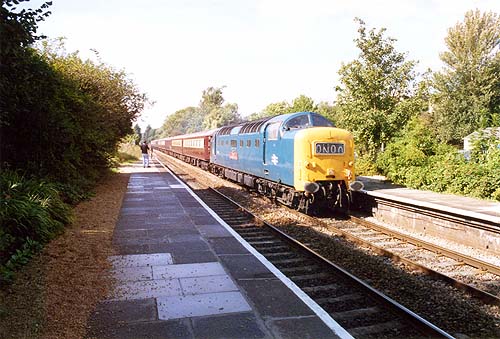
A
class 55 "Deltic" Co-Co hauling a Charter train
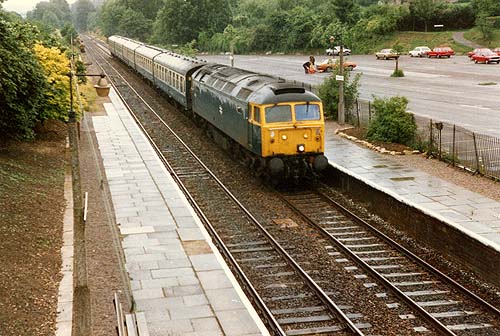
A
British Rail class 47 Locomotive entering Bradford on Avon Station
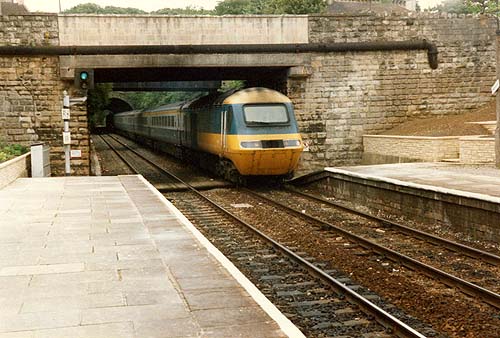
An
HST Locomotive entering Bradford on Avon Station. Note the signal BJ102
operated from Bradford Junction Signal Box.
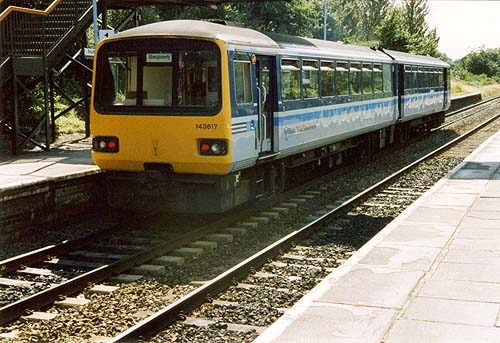
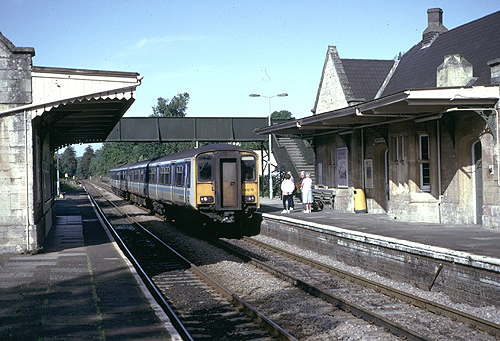
A
Class 150 entering Bradford on Avon Station.
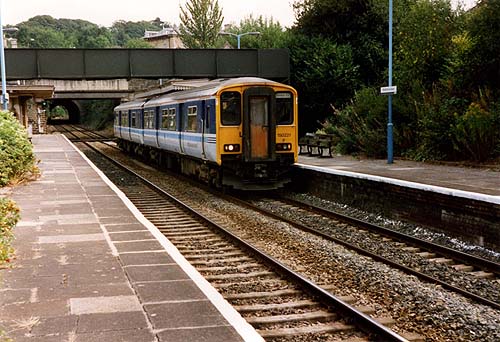
A
class 150 no. 150221 at Bradford on Avon Station heading for Bristol Temple
Meads
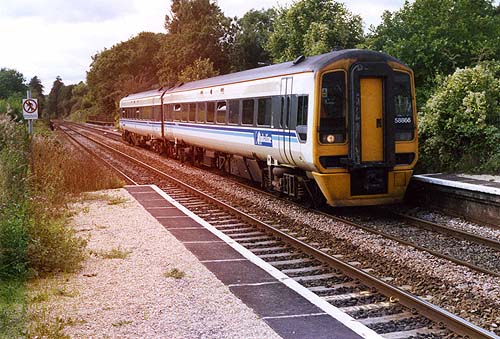
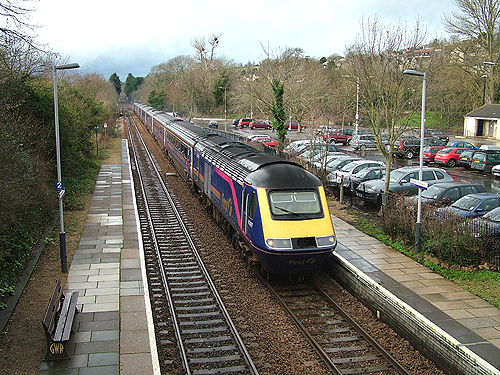
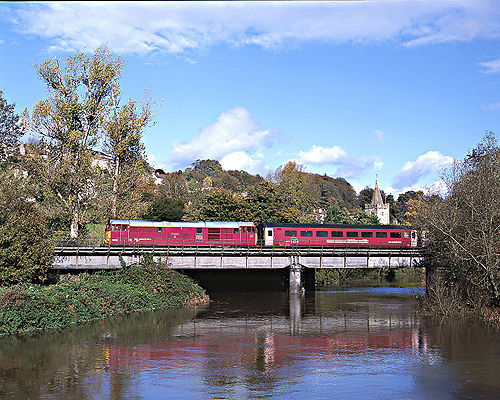
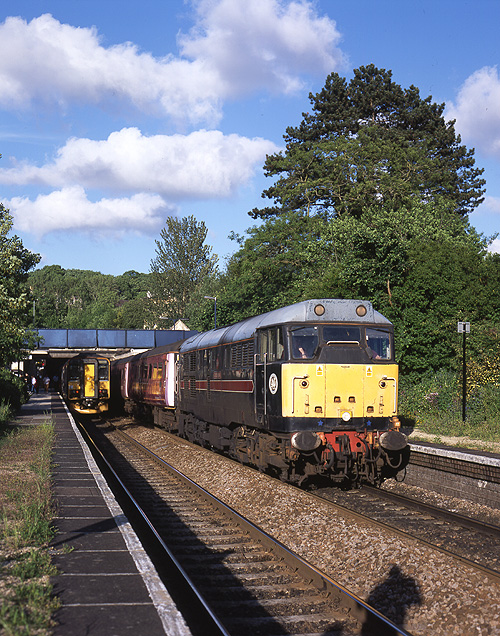
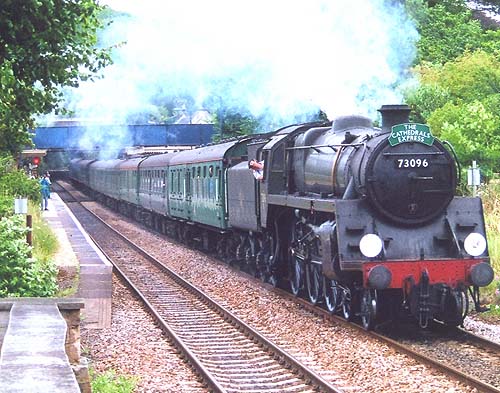
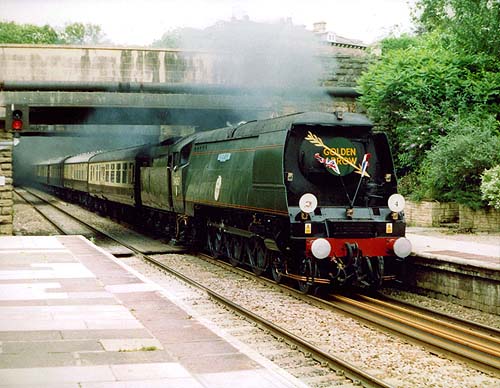
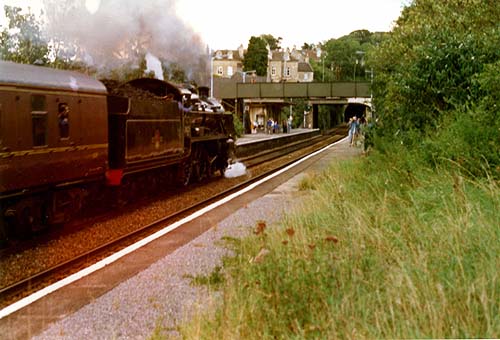
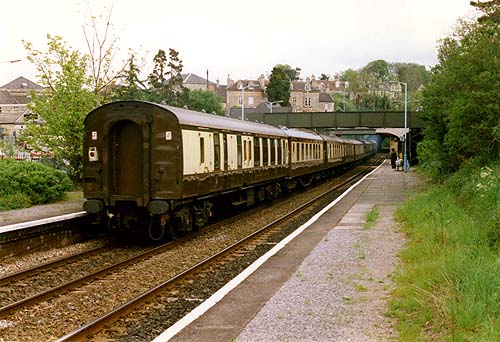
the
return Orient Express passing Bradford on Avon

An
unusual view looking down the platform from the footbridge in 2004. The
train approaching is the South West Trains Bristol Temple Meads to Waterloo.
And the one nearest going on to Bristol temple Meads
2006
On 1 April First Great Western, First Great Western Link and Wessex Trains combined into the new Greater Western Franchise. First were announced as the operator of the combined franchise in December 2005 for a 10-year period
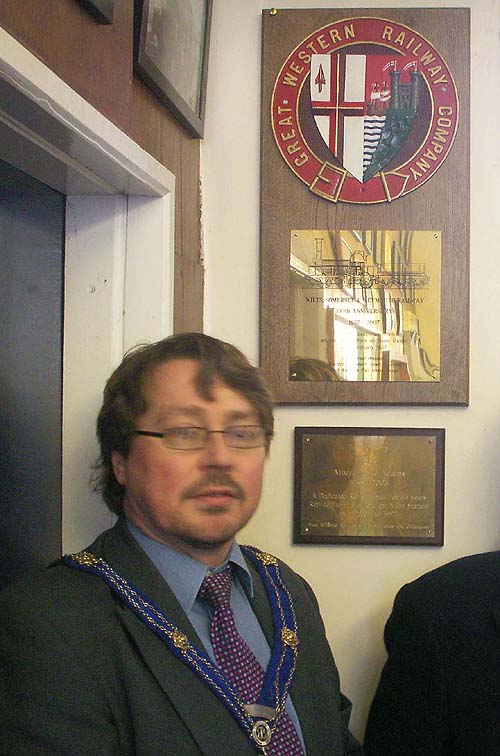
2007
locomotive had been a regular visitor to the Station in the past
